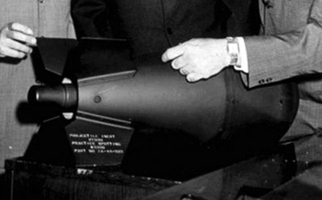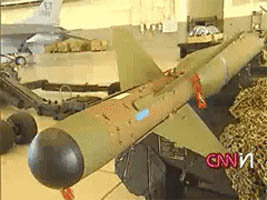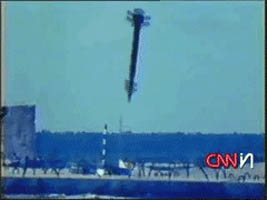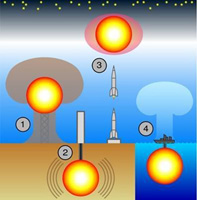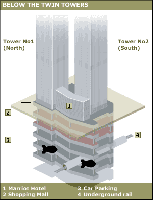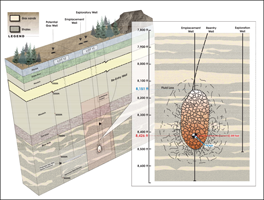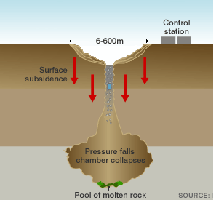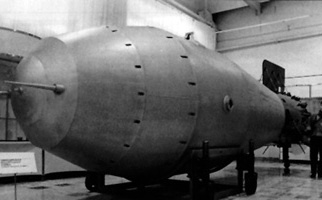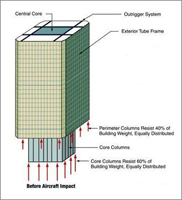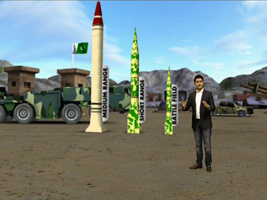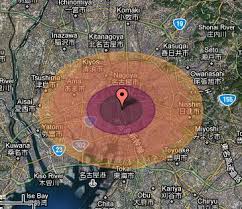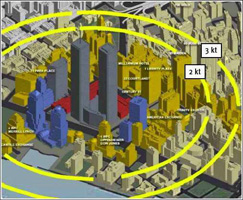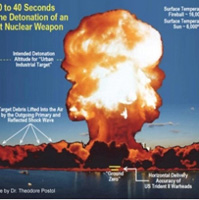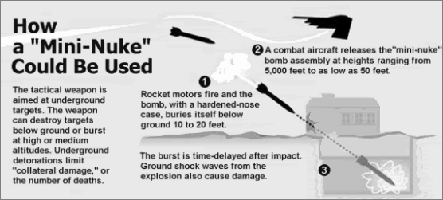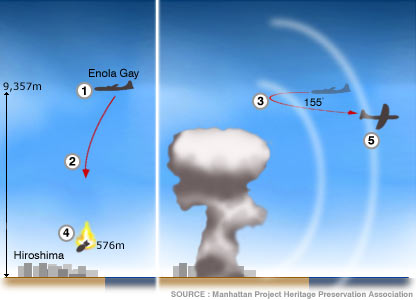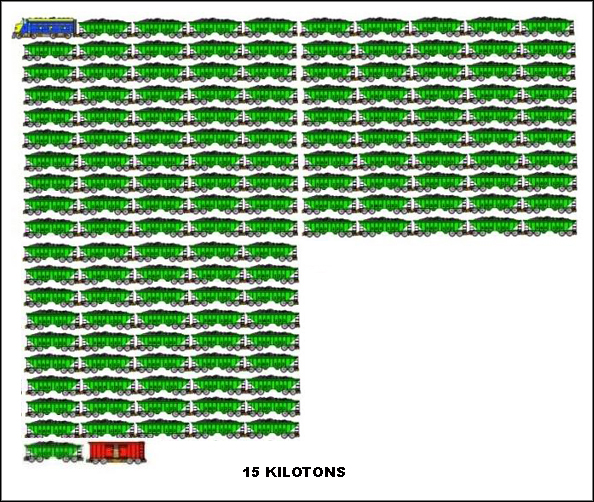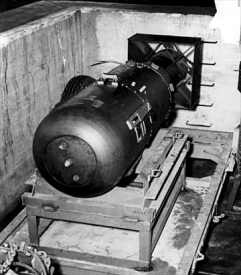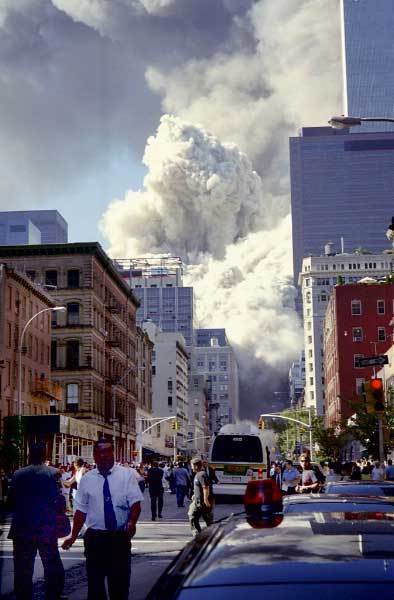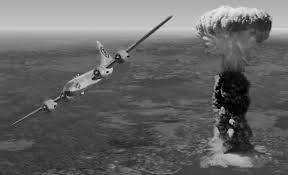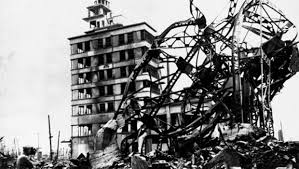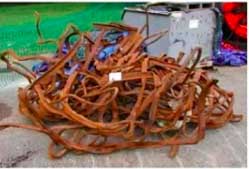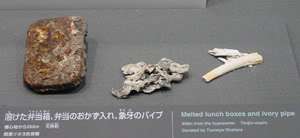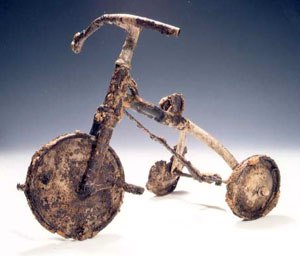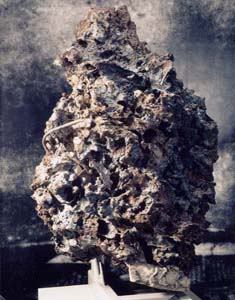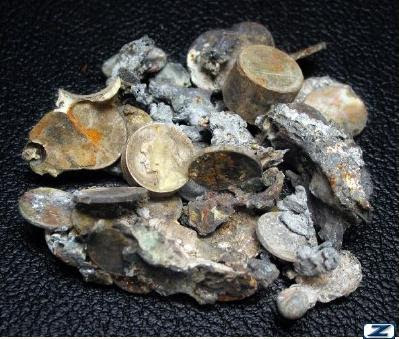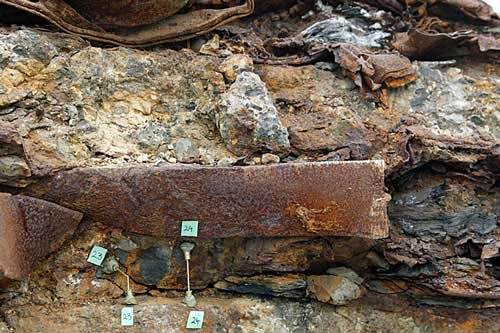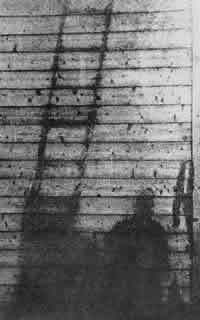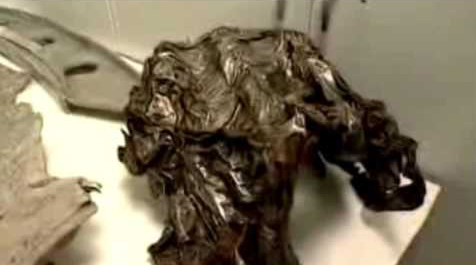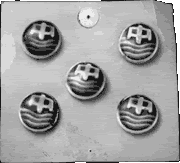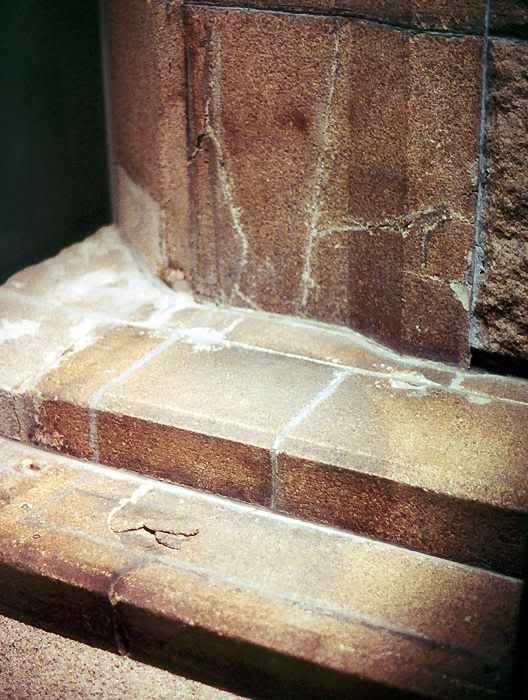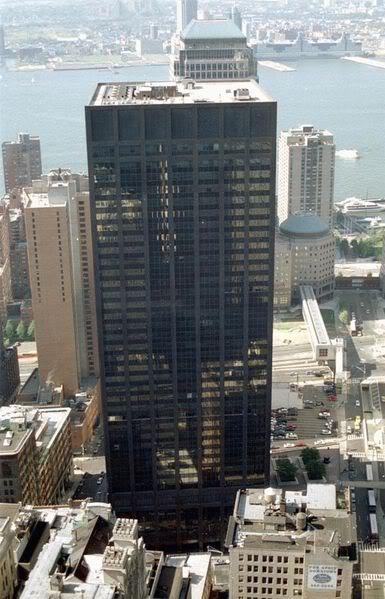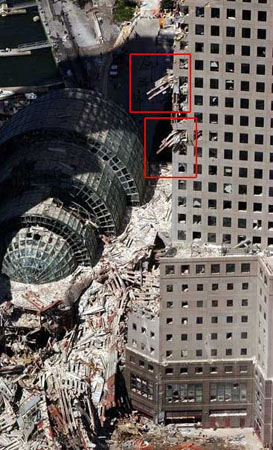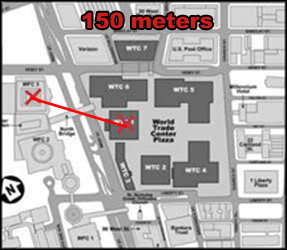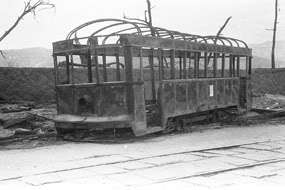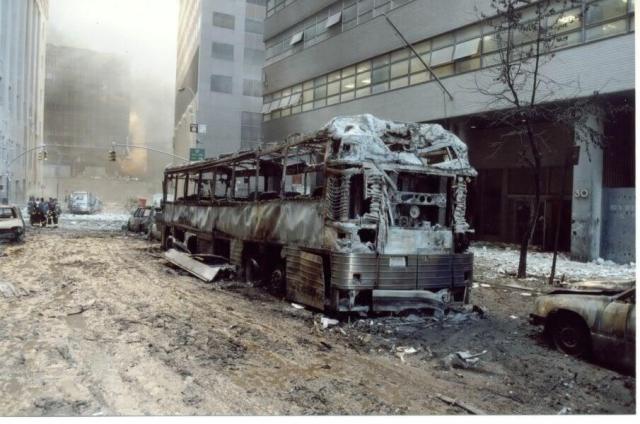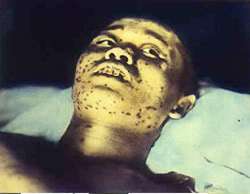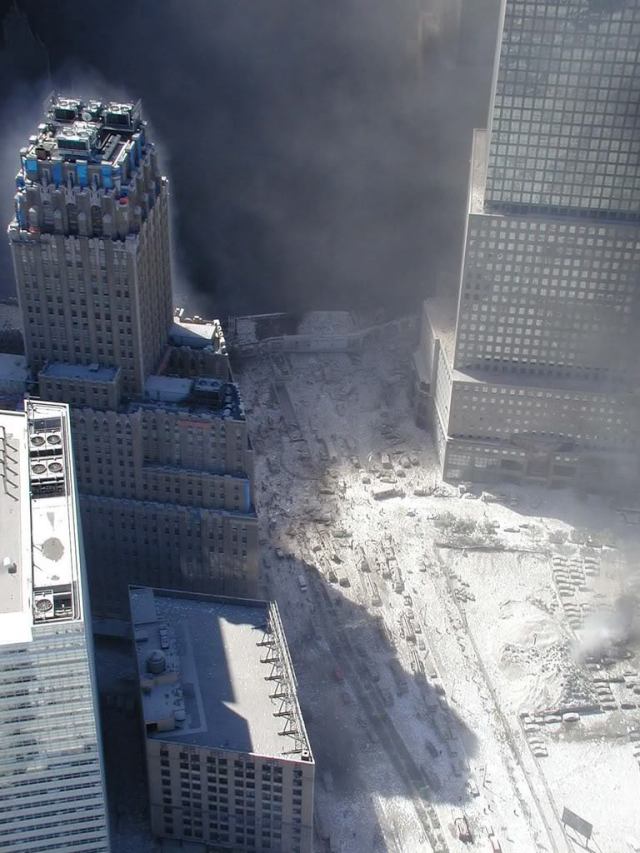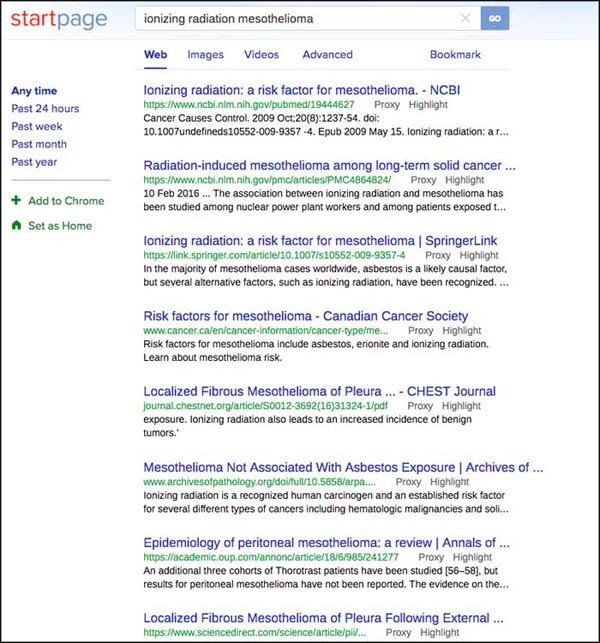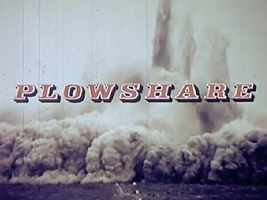WARNING: DISTRESSING PHOTOS SHOWING DEAD BODIES
In this section, we explain how nuclear bombs and conventional ordnance were used to destroy the towers. Nuclear devices were an integral part of the plot to bring the towers down. They were required to take out the destruction-resistant core of the towers and to effect complete destruction of the evidence.
Conventional bombs were used to mimic floor-by-floor pancake-style collapse of a gravity-driven fall. The nuclear devices were detonated in the basement levels underground and were of the “mini-nuke” range (less than 1 kiloton). This is why the amount and area of destruction is much less than are seen in the Hiroshima and Nagasaki detonations. However, the level of destruction is consistent with the use of tactical nukes.
We also include in this section a discussion about why thermite could not have been the principal explosive used.

Nukes can be tiny too–Davy Crockett nuke
One of the early tactical nukes or mini-nukes was the Davy Crockett. Development started in the late 1950s.

Davy Crockett nuclear gun. 1961 Wikipedia
It was a gun-type nuke. The size of the explosion was only 10 tons of TNT.
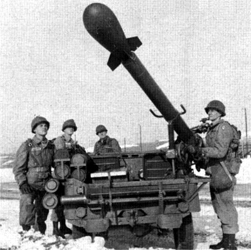
Davy Crockett recoilless gun
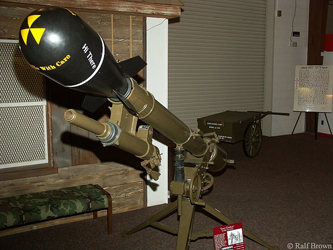
Davy Crockett nuclear gun

World’s smallest nuke (Davy Crockett) being fired – a 10-ton explosion (video)
Davy Crockett nuke test
VIDEO: M388 Nuclear bomb testing – Davy Crockett Youtube
The explosion showed mainly a smoke plume with little disturbance to the surface.

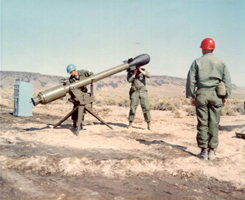
Testing the Davy Crockett

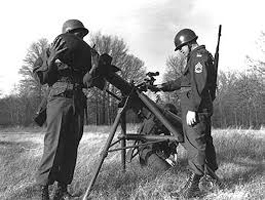
Davy Crockett
Lightest nuclear warhead made by the USA

Warhead of the Davy Crockett. U.S. officials examine a M-388 Davy Crockett nuclear weapon. It used one of the smallest nuclear warheads ever developed by the United States. It could fit into a foot locker. Wikipedia

W-54 warhead
The lightest nuclear warhead ever acknowledged to have been manufactured by the U.S. is the W54, which was used in both the Davy Crockett 120 mm recoilless rifle-launched warhead and the backpack-carried version called the Mk-54 SADM (Special Atomic Demolition Munition). The bare warhead package was an 11 in by 16 in (28 cm by 41 cm, small enough to fit in a footlocker-sized container) cylinder that weighed 51 lbs (23 kg). Wikipedia
- Dimensions: 11 x 16 inches (28 x 41cm)
- Weight: 51 lbs (23 kg)
Comparison with Hiroshima and Nagasaki bombs
Hiroshima and Nagasaki
The Hiroshima bomb was 15 kilotons (15,000,000 kg TNT). Nagasaki was 20 kilotons (20,000,000 kg TNT). Both were air bursts – detonations were high in the air above the cities. The Hiroshima bomb was detonated about half a kilometer above the city. Detonating a bomb in the atmosphere maximizes the effects.
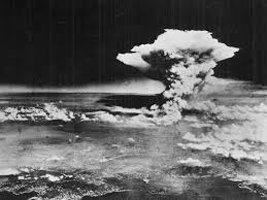

LEFT: Hiroshima bombing created a huge mushroom cloud; the bomb was 15 kilotons in size. RIGHT: Artwork showing an American bomber dropping the atomic bomb.
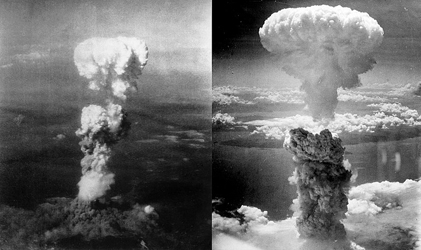
LEFT: Hiroshima; RIGHT: Nagasaki (Picture taken by Charles Levy)
At the time this photo was made, smoke billowed 20,000 feet above Hiroshima while smoke from the burst of the first atomic bomb had spread over 10,000 feet on the target at the base of the rising column.
Comparison chart
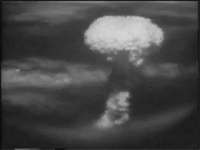 vs
vs 
Nagasaki bombing vs WTC bombing. (Nagasaki GIF is from this video (“ngbomb2a”) Dailymotion | cddc.vt.edu.)
Hiroshima |
World Trade Center, underground mini-nuke |
|
| Size of bomb | 15 kton | < 1 kton |
| Type of detonation | Air burst, 576 meters above the city | Underground, in basement of building, under mountain |
| Fireball | Visible | Not visible |
| Crater | No | Crater, giant pothole formed |
| Mushroom cloud | Huge mushroom cloud high in the air | Small one hugging the building |
| Debris pattern | Debris scattered far & wide | Debris thrown up in air, thrown 150 m out (WTC) |
| Surge clouds | Not seen | Seen |
| Aim | Destroy the city | Destroy the building or mountain, make harbor |
| Conventional bombs used | Not simultaneously with nuke bomb | Yes, initial explosions in WTC are from conventional bombs. |
| Cancer | Yes, cancer spike | Yes, 1 in 10 WTC workers have cancer (2017) |
 vs.
vs. 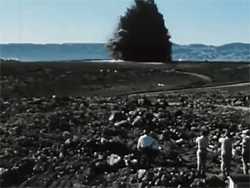
LEFT: Nagasaki. RIGHT: An underground nuke test: no huge mushroom cloud, surge clouds are prominent at the base, no fireball, much dirt and debris thrown up in air.
WTC was underground nuke detonation
In contrast, the detonations of mini-nukes have much weaker effects. They can resemble detonations of conventional ordnance. In the GIFs below, both of underground explosions, there is no visible fireball or huge mushroom cloud.
In both cases, much debris and dirt is thrown up into the air. One of the main characteristics of these underground nuclear explosions is that a crater or large pothole is created. In addition, a large quantity of dust is formed.
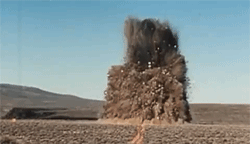 and
and 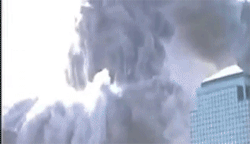
LEFT: Underground nuclear test. RIGHT: Underground (basement) nuclear explosion of small yield (< 1 kiloton). However, you can still see brightening in the screen due to the radiance of the fireball that is hidden.
Comparison chart of Hiroshima nuke and mini-nuke detonated underground
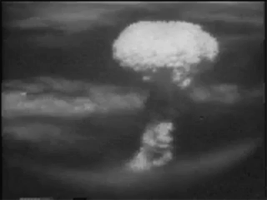 vs.
vs. 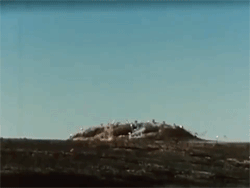
LEFT: Nagasaki bombing. From video (“ngbomb2a”) Dailymotion or cddc.vt.edu. RIGHT: Underground peaceful nuke test
 vs
vs 
LEFT: 1946 test of a Hiroshima type of surface detonation nuke bomb RIGHT: Underground nuke test.
Earth penetrator explosion looks like WTC explosion
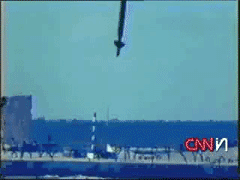 and
and 
LEFT: Bunker buster that penetrates deep underground and then explodes while under the ground, shooting out streamers of debris. RIGHT: WTC explosion: shows the same ejection plumes and streamers.
Surge clouds in underground nuke explosions
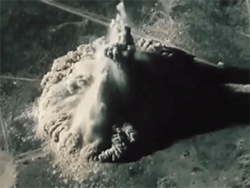 and
and 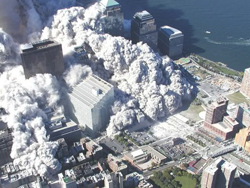
LEFT: Surge clouds of an underground nuke detonation. Note the central column of debris and the small mushroom cloud atop it. RIGHT: Surge clouds of the WTC underground detonation. Surge clouds are a prominent feature of underground nuke detonations.
WTC: combination of conventional bombs and nuke bombs
Small explosion clouds of conventional bombs are mixed with the debris cloud of the nuke basement detonation that destroyed the core of the tower and vaporized the concrete. The conventional bombs were placed on the above-ground floors on and below the fracture level. The nuke was placed in the basement (underground).
As a result, the pattern of explosions is complex.
Complex pattern of explosions
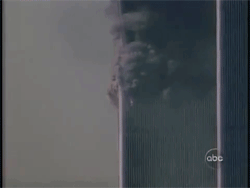

LEFT: A mix of conventional “bomblets” and a mini-nuke bomb. You can see a
“large” mushroom cloud swirling on its stem in the end frames. This is the nuke bomb. RIGHT: Nuke bomb produces the streams of debris and flings heavy debris far out and wide. Conventional bombs produce smaller explosion clouds that pop out like popcorn.
Conventional ordnance
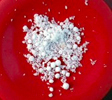
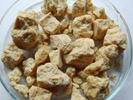
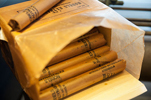

1) Ammonium nitrate; 2) TNT; 3) Dynamite; 4) Gelignite
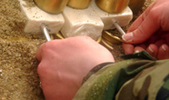
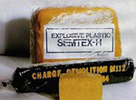
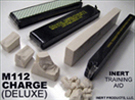
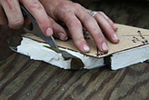
5) C4; 6) Semtex; 7) C4; 8) C4
Mini-nukes
There are many different kinds. All of them are low-yield. At sizes of less than 1 kton, they can destroy a building or two, but probably not much else.
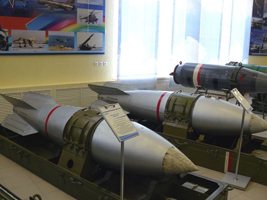

LEFT: Tactical nuke RIGHT: “backpack nuke”
Use of conventional bombs hides the use of nuke bomb
The use of conventional bombs masks the use of the nuke bomb. The combined and simultaneous use of both types of bombs produces a confusing and complex picture. The small explosions of many conventional bombs, concealed on the floors along the length of the tower below the fracture point (where the planes entered the towers), hides the massive explosion of the nuke basement bomb, which was done to take out the destruction-resistant steel and concrete core, among many other reasons.
This is probably why many people missed the nuke detonation despite suspecting bomb use in the WTC attacks.
However, the nuclear bomb detonation is clearly seen in the later stages of the explosion. There is a central column of debris, a mushroom cloud sitting on top of that, and a cushion of surge clouds at the base, as well as streamers and plumes of debris, including heavy debris like steel columns and tridents.

This GIF shows the smaller conventional bombs exploding like popcorn well in the initial frames. In the later frames, you can see the larger mushroom cloud on its stem, plumes and streamers of debris.
Conventional bomb vs. nuke bomb
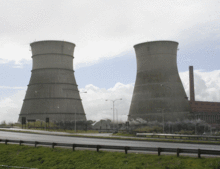 vs.
vs. 
LEFT: Conventional bomb. Implosion of the Athlone Power Station cooling towers on 22 August 2010. (Wikipedia) RIGHT: Underground nuke test. The WTC detonations were a combination of both types.
WTC & underground nukes: same shape of debris cloud
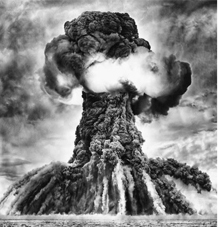 and
and 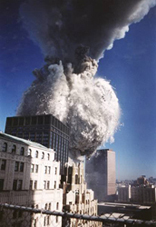
Chagan test was a peaceful underwater test of nuke in the USSR.
The explosions of underground nuke tests and WTC explosion (at end-stages) share similar characteristics.
- Mushroom clouds
- Central chimney
- Surge clouds at the base
Underground nuke test compared with WTC nuke
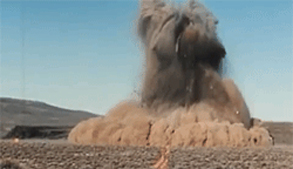
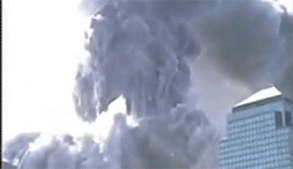
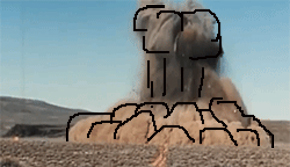
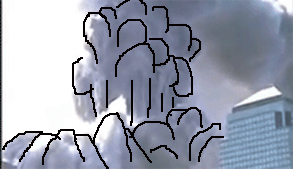
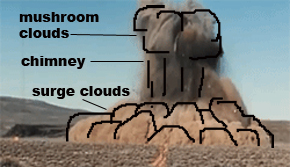
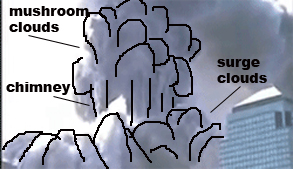
 vs
vs 
Chagan test and WTC underground nuke
 and
and 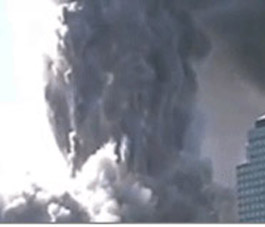
More on underground nuke tests below.
Underground nuke tests of Operation Plowshare
Operation Plowshare was a program of the U.S. government to test the feasibility of using nukes for peaceful purposes such as construction purposes. Most of the tests were conducted underground.
Since the nuke explosions of the WTC towers are posited to be underground nuke detonations, it is useful to examine the Operation Plowshare nuke detonations and compare them with the WTC ones.
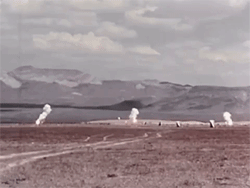
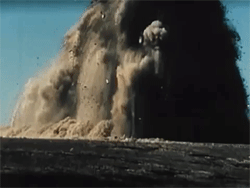
Dirt and particularized debris is thrown up and descends in streamers and plumes. Surge clouds can be seen spreading outwards while hugging the ground.


A lot of dirt is thrown out as the soil is displaced by the force of the explosion. The ground is lifted up.
Video: The World’s Smallest Nuke
VIDEO: The World’s Smallest Nuke Youtube
Backpack nukes
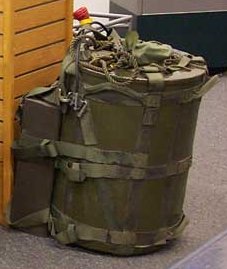
SADM or backpack nuke
These are called SADM or Special Atomic Demolition Munition. They can be carried like a backpack. They can even be deployed by parachute. They contained the W-54 warhead.
Special Atomic Demolition Munition (SADM)
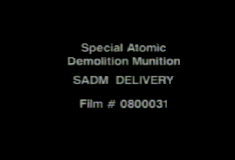
GIF from training film for SADM delivery
This old training film shows SADM being transported under water and then being deployed by parachute. The atomic device was small and portable enough to be carried as a backpack.
Troops were trained to parachute into Soviet-occupied western Europe with the SADM and destroy power plants, bridges, and dams.
Something similar, portable and easily transported and concealed, could have been used to destroy the towers in the WTC complex.
VIDEO: American SADM Dailymotion

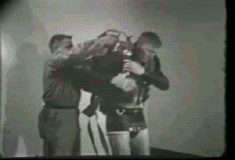

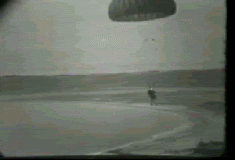
Images from the training film

The components of a backpack nuke when taken apart.
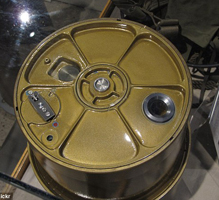

The cylindrical metal casing for the nuclear device.
Extremely small (as small as 5 inches (13 cm) diameter and 24.4 inches (62 cm) long) linear implosion type weapons, which might conceivably fit in a large briefcase or typical suitcase, have been tested, but the lightest of those are nearly 100 pounds (45 kg) and had a maximum yield of only 0.19 kiloton (the Swift nuclear device, tested in Operation Redwing’s Yuma test on May 27, 1956). The largest yield of a relatively compact linear implosion device was under 2 kilotons for the cancelled (or never deployed but apparently tested) US W82-1 artillery shell design, with yield under 2 kilotons for a 95 pounds (43 kg) artillery shell 6.1 inches (15 cm) in diameter and 34 inches (86 cm) long. Wikipedia
“Swift”–smallest-diameter nuke–5-inch diameter and 0.19 kt
The smallest diameter US test device publicly known was the Livermore “Swift” device fired in the Redwing Yuma shot on 28 May 1956. It was 5 inches in diameter. It was 2 feet in length and weighed 96 pounds. The smallest-yield nuke, however, was the M-388 nuclear device, used in the Davy Crockett nuke gun (10 tons of TNT or 0.01 kton).
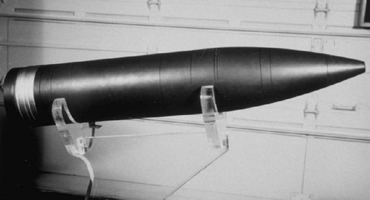
The smallest diameter US test device publicly known was the Livermore “Swift” device.
| Test: | Yuma |
|---|---|
| Time: | 19:56 27 May 1956 (GMT) 07:56 28 May 1956 (local) |
| Location: | Eniwetok Atoll, Aomon (Sally) Island |
| Test Height and Type: | 205-foot tower |
| Yield: | 0.19 kt |
This was a UCRL linear implosion design intended for air defense warheads. The device, known as Swift, was a boosted asymmetrical design. The device failed to boost however, and the yield was far below predictions. The Swift was only 5 inches in diameter, and 24.5 inches long, and weighed 96 lb. This was the smallest diameter, and lightest nuclear device tested up to this time. It used Octol 76/24 as the explosive and was presumably a plutonium fueled device.
The Age of the Mini-nuke: Tactical Nukes
A tactical nuclear weapon (TNW) or non-strategic nuclear weapon is a nuclear weapon which is designed to be used on a battlefield in military situations, mostly with friendly forces in proximity and perhaps even on contested friendly territory. This is opposed to strategic nuclear weapons which are designed to be mostly targeted in the enemy interior away from the war front. (Wikipedia)
Tactical nukes differ from other types of nukes in that they are designed for use on the battlefield. If they are of low yield, less than 3 kton, they are called mini-nukes. They are used to demolish buildings and other types of targeted specific sites. They are useful for destroying hardened structures. Some of them are dropped from planes and explode after penetrating deeply into the ground–the so-called “earth-penetrators”. Some are “suitcase nukes” or “backpack nukes”.
Tactical nukes, if low-yield, do not release as much radiation as conventional nukes. The effects of ionizing radiation may not be readily apparent. In addition, depending on the manner in which they are used–exploded underground, dropped and detonated in the skies from a plane, fired like a rocket at a target on the ground–the effects will be different. Fireball, mushroom cloud, widespread blast effects–the absence or presence of–will differ, depending on the situation.

Comparison of some nukes. The last one, used on the battlefield, would be considered a tactical nuke.
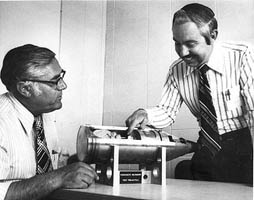
U.S. scientists with a full-scale cut-away model of the W48, a very small tactical nuclear weapon with an explosive yield equivalent to 72 tons of TNT (0.072 kiloton). Around a thousand of these shells were produced during the Cold War. (link)

Russian OTR-21 Tochka missile. Capable of firing a 100 kiloton nuclear warhead a distance of 185 km (Wikipedia)
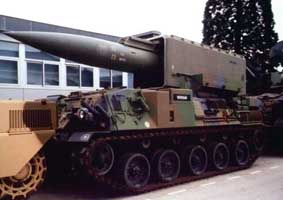
French Pluton missile circa 1970s. Capable of firing a 15 kiloton nuclear warhead a distance of 120 km (Wikipedia)
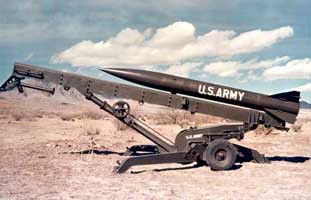
American MGR-3 Little John missile, measuring 4.4. meters long with a diameter of 32 cm and a weight of 350 kg. Capable of firing a W45 warhead (10 kiloton yield) a distance of 19 km (Wikipedia)
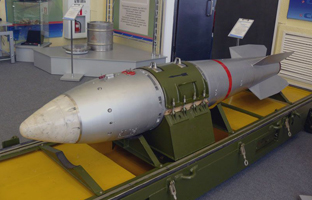
Soviet RN-28 tactical nuke. Weight 250kg; variable yield, either 1 to 10kt or 5 to 30kt depending on the source.

Tactical nukes in a museum of nuclear weapons in Russia.
Earth-penetrating tactical nukes AKA bunker busters
Bunker busters, or earth-penetrating weapons, can be nuclear or non-nuclear. The bunker buster is designed to penetrate soil, rock or concrete. The nuclear warhead of a nuclear bunker-buster, when it reaches the underground target, explodes, and destroys the underground target. These weapons are usually used to destroy hardened underground bunkers and similar structures, hence the name “bunker buster”.
Low-yield and low-radiation
Because the explosion is underground, a larger fraction of its energy ends up in the ground compared to a surface burst or air burst nuclear weapon.
Therefore, a lower yield weapon can be used, which in turn leads to the reduced release of radioactivity and smaller fallout.
However, as significant amounts of rock and soil are vaporized and lifted into the atmosphere, health-endangering fallout is still generated.
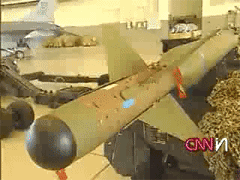
Taken from CNN video
B-61 nuclear bomb – can be used as a mini-nuke
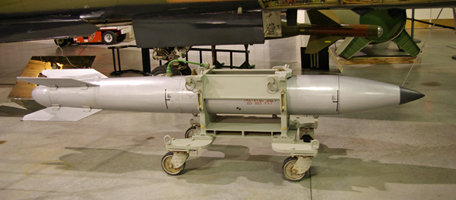
B-61 nuclear bomb. Shown is the training unit, used to train crews. It contains inert materials. (Wikipedia)
The B-61 nuclear bomb can be used as a bunker buster. It is a low to intermediate-yield (0.3 kilotons to 340 kilotons) tactical nuclear weapon. 0.3 kton is the equivalent of 300 ton of TNT (mini-nuke yield size). It is 3.56 meters long, has a diameter of 33 cm, and weighs 320 kg. (Wikipedia)
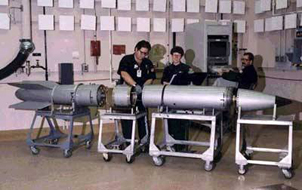
A B61 bomb undergoing disassembly.
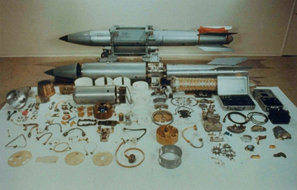
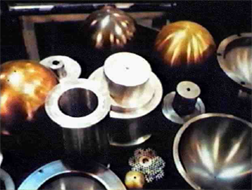
LEFT: B61 bomb in various stages of assembly. The nuclear component is contained in the small, silver cylinder near the left upper middle of the picture. (Wikipedia) RIGHT: Internal nuclear components of the B61 bomb. (Images: Wikipedia)
Mini-nukes useful for destroying hardened structures like buildings and bunkers
Such tactical weapons as nuclear bunker busters were probably employed because of their ability to destroy hardened structures. The WTC Towers were built to withstand strong forces such as a plane crashing into them. Mindful of this, and aware that destroying the steel core of the Towers as well as punching a hole in the steel bar netting of the periphery for a plane to slip inside would pose a considerable challenge, the planners decided to employ mini-nukes.
Tasks that nuclear bunker busters can perform with ease:
- Punching a hole in the steel grid mosquito netting of the Twin Towers
- Destroying the steel core of the Twin Towers
Video: B61-12 – nuclear bunker buster
VIDEO: The Earth-Penetrating Capability of The B61-12 Nuclear Bomb (Sandia National Laboratories) Youtube
Tactical nuke explosions can look like conventional detonations

World’s smallest nuke (Davy Crockett) being fired – a 10-ton explosion (video)

Hiroshima-type atomic bomb test in 1946, more than 15 kton (video)
Summary of nukes
Different typesThese can come in different forms and be used in different modes. Some are dropped from planes like conventional nukes and detonated in the air, causing a picture of destruction that is very similar to Hiroshima or Nagasaki.
Different modes of deliveryOthers are left in situ in the target area and are detonated by remote control. They can be detonated underground, in deeply buried locations or on the surface of the ground. They can be detonated under water. These can demolish specific buildings, leaving the surrounding structures relatively intact. The U.S. government considered using nukes for peaceful building purposes–to create canals, harbors and roads. These nukes would be detonated underground to blow up structures above it, such as mountains. For many years, the radiation hazard was considered tolerable enough for their use in peaceful demolition to be considered.
Different modes of detonationStill, other tactical mini-nukes can be fired like a rocket to land on a target and detonate at that spot. And others can penetrate the ground after being fired from a launcher or dropped from a plane, and after penetrating the earth’s surface and burrowing deeply into the ground, detonate, to destroy structures under the ground.
LEFT: Davy Crockett being fired, above surface detonation RIGHT: The Schooner Event was part of the Plowshare Program. Video. Other types of nuke detonation involve dropping them by parachute and delivering them by a diver to the site and detonating them remotely.
Different sizes and yieldsMini-nukes by definition have yields that are of “fizzle yield” – yields considered to be failures in nuke tests. However, the definition of a “fizzle yield” is arbitrary. For a nuke of 15 kton, a fizzle yield would be 1 kton. But 1 kton can destroy a city tower. For someone who is interested in demolishing a building, this yield would be more than adequate and would not be considered a fizzle yield. Nuke sizes can vary from 0.01 kton (10 tons of TNT) to megatons. The USSR’s Tsar Bomba is 50 megaton (50 million ton) and is the largest known detonated nuke bomb.
Low-yield nuke bombs: M-388 nuclear device is only 10 tons of TNT; suitcase bomb.
LEFT: Tsar Bomba: this USSR bomb is the largest one detonated. It has a yield of 50 megatons or 50 million TNT. RIGHT: Tsar Bomba test. Different purposesA wide variety of purposes for nuke use exists. Some are for use on the battle-field like tactical nukes, others are for dropping above a city to destroy it, like the Hiroshima bomb, and others have peaceful purposes such as demolishing structures to create a harbor.
LEFT: Operation Chariot scheme, using thermonukes to build a harbor. CENTER: Operation Nougat: Gnome cavity in salt rock. This was created by an underground nuke blast in salt rock. Note the size of the man. RIGHT: Steel and concrete core of the WTC towers was resistant to destruction. Only nukes could reliably destroy it.
LEFT: Tactical nukes are for use on the battle field. RIGHT: The nuke dropped on Hiroshima caused a wide area of destruction.
LEFT: The area of damage left by the WTC nukes. RIGHT: A large nuke dropped from a plane and detonated in the skies would produce a large mushroom cloud.
Mini-nuke has been considered by the U.S. government against Iran’s underground bunkers. Different effectsThe effects will differ depending on yield, type of bomb, mode of firing, mode of delivery, and whether conventional bombs were used alongside the bomb. Rumors that tactical mini-nukes have been used in battlefields–Afghanistan, Iraq and YemenMini-nukes have been around since the 1950s. They are nothing new. Often they are overlooked when people talk about nukes. These mini-nukes in general do not show the same effects as medium-sized or large nukes, and if they do, the effects are not on the same scale as these larger nukes. It’s time for people to broaden their concept of nukes and consider whether they could have been used in the WTC attacks. |
Basement tactical nukes and plane tactical nukes
Basement tactical nukes were used to destroy the steel cores of the towers, and it’s highly likely a DU missile (a bunker buster) or a tactical nuke was fired from the planes to punch a hole in the steel lattice of the periphery of the WTC Towers and the reinforced concrete walls of the five-ringed Pentagon.
Why were tactical nukes used on 9/11?
- To take out the steel and reinforced concrete core
- To achieve complete destruction – in order to destroy the evidence
- To simulate a pancake collapse
- To conceal the fact that bombs were used – tactical nukes are compact and can be transported and hidden easily.
- To disguise a demolition wave caused by conventional bombs
Forty-foot deep crater at the WTC

The 40-ft deep “pothole” (nytimes.com)
“Excavation at the World Trade Center site has uncovered, among other geologic features, a 40-foot glacial pothole … A fantastic landscape in Lower Manhattan — plummeting holes, steep cliffsides and soft billows of steel-gray bedrock, punctuated by thousands of beach-smooth cobblestones in a muted rainbow of reds and purples and greens — has basked in sunlight this summer for the first time in millennia.” nytimes.com
In the crater, there appears to be translucent glass-like material. This could be rock and sand that were vitrified in the explosion.
In addition, it was reported that thousands of colored “cobblestones” were uncovered at the site during excavation. These could be trinitite. Trinite can come in a variety of hues, including green, purple and red.
How the crater was formed
Placement of bombs in the WTC
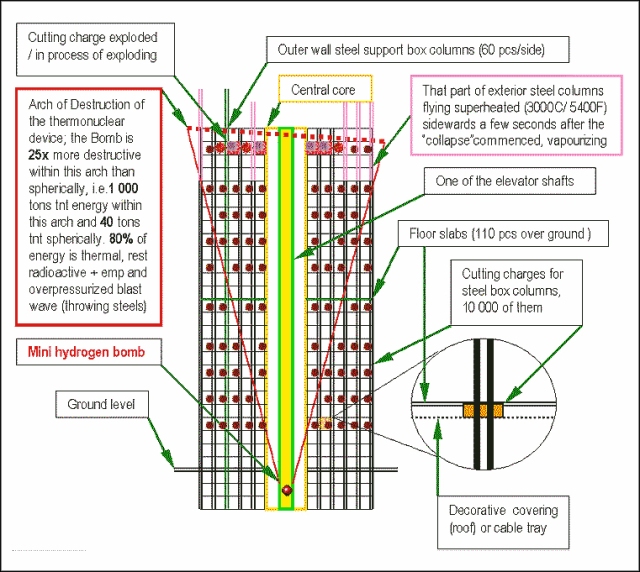
Schematic provided by “anonymous insider” (Finnish military expert). The nuke is placed in a basement level. This shows where the conventional bombs and mini-nuke (thermonuclear or hydrogen bomb) were placed.
Shallowly-buried detonation
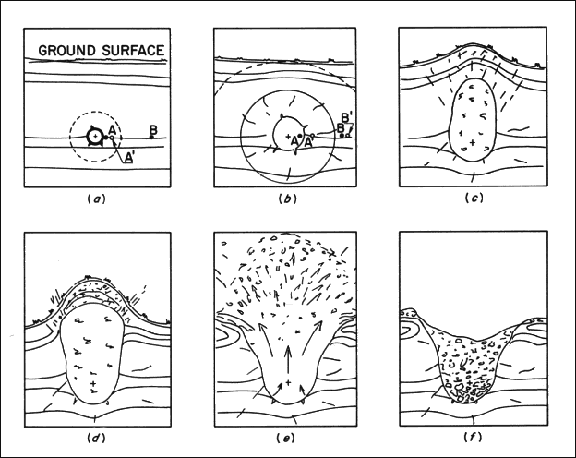
Phases in a shallow underground explosion. From The Constructive Uses of Nuclear Explosives, McGraw-Hill Book Co., LC 68-11621. nuclearweaponarchive
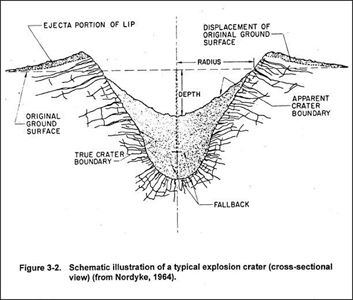
Schematic illustration of the final explosion crater of a shallowly buried device
Deeply-buried detonation
In this sort of detonation, a device is exploded inside a cavity deep underground.
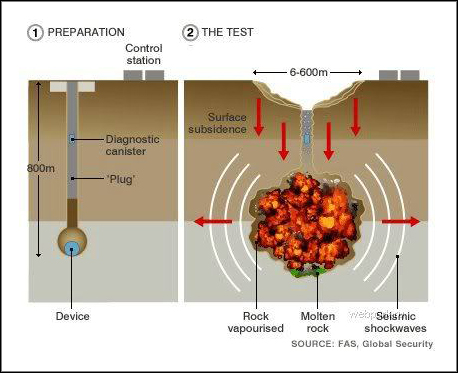
The device is detonated in the control room (BBC)
The pressure in the cavity collapses, and a “rubble chimney” is formed. A crater sits atop on the surface.

In the aftermath of the explosion, the gas cools and the chamber collapses producing a crater. (BBC)
This diagram shows what happens in a deeply buried explosion. First of all, the surface of the earth is lifted by the expansion of heated gases from the explosion. In the second stage, the surface starts to collapse. The cavity collapses on itself and a rubble chimney is formed. At the base is a puddle of melted rock (radioactive glass). After a while, the ground above the rubble chimney starts to sink and a depression is formed – the third stage. This is the subsidence crater.
Subsidence crater
A subsidence crater is a depression left on the surface after an underground explosion. It is created when the roof of the cavity caused by the explosion collapses.
Underneath the pile of debris at the World Trade Center site was a huge subsidence crater. The height of the debris pile was small because most of the debris lay in the crater, filling it up and hiding it.

Under this debris is a large crater. The debris from a 110-storey tower and the contents inside it fill up the crater.
Gnome Test
The Gnome test was an underground test of a small nuke (3-kiloton size). The nuke was buried under rock. This is similar to the detonation of the WTC nukes, which were buried in the basements and were enclosed by rock foundation below and basement slurry walls on the sides.
The Gnome Test was part of Operation Plowshare, a study done to assess the feasibility of using nukes for civilian construction purposes.
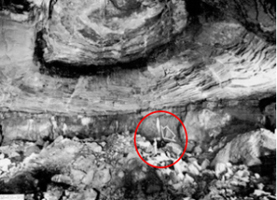
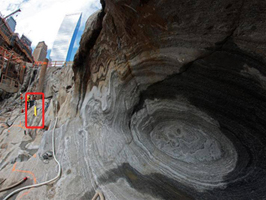
LEFTL Nougat Gnome Crater. See the man standing under the arrow in the red circle. This gives some idea of the size of the cavity. The pothole in the WTC was 40-foot deep. Picture from Operation Nougat. RIGHT: Man in yellow standing in the red rectangle.
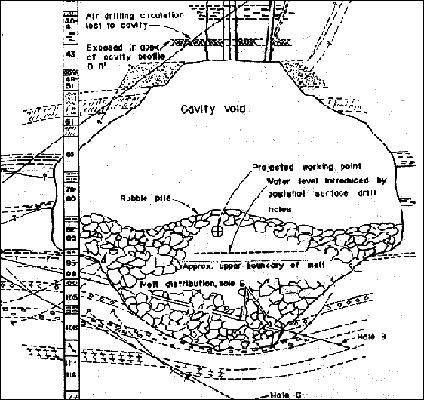
Gnome cavity. (nuclearweaponarchive)
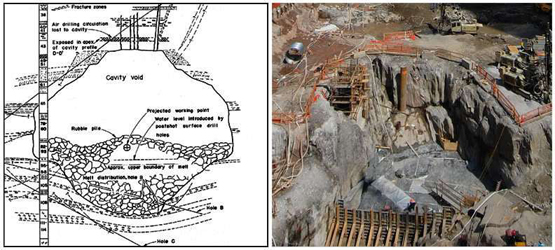
Comparison of Gnome cavity and the pothole found at Ground Zero. (Photo on right from nytimes.com)

Comparison of Gnome cavity and the pothole found at Ground Zero. Notice the arrow pointing to the man in the photo on right. (Photo on left from nytimes.com)
Pictures of the giant pothole left after the event
The pothole is the cavity carved in the rock foundations underneath the WTC towers after detonation of the mini-nukes. The explosive energy was able to create this deep crater in something as hard as rock. Only something powerful enough, like a nuke, could have caused this cavity.

The pothole left after the event (theeventchronicle)

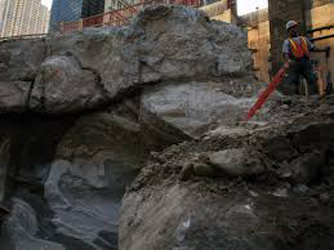
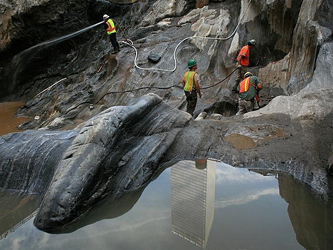

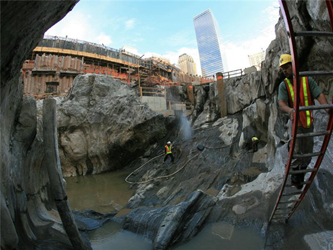

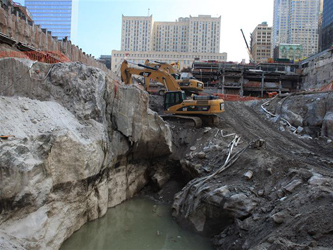
Comparisons of the “pothole” and the Gnome cavity
The 40-foot deep “pothole” resembles the cavity left after the Gnome underground nuke tests in salt rock formations. In the pictures below an arrow points to the man standing inside the cavity created by the Gnome test, showing the size of the cavity. In the WTC picture below, the yellow figure is a man standing in the WTC cavity.

LEFT: Pothole at the WTC RIGHT: Cavity in rock left after underground nuclear test (Gnome Test). Note the arrow pointing to the man. From Operation Nougat
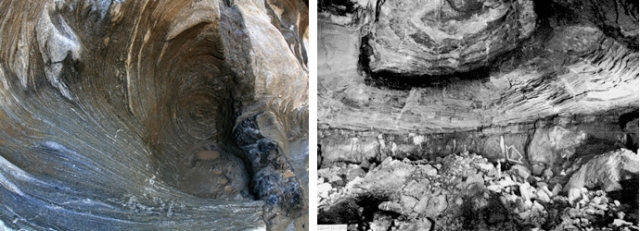
LEFT: Pothole at the WTC. RIGHT: Cavity in rock left after underground nuclear test (Gnome Test). Note the arrow pointing to the man. From Operation Nougat
Turned into “glass”
“Excavation at the World Trade Center site has uncovered, among other geologic features, a 40-foot glacial pothole”
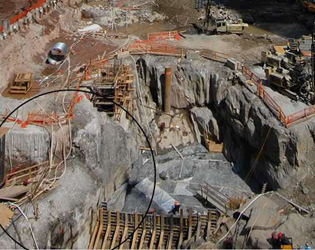
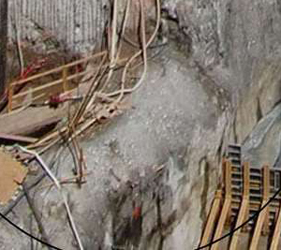
LEFT: The crater in the bedrock under the Twin Towers. RIGHT: Detail in photo: Vitrified rock
Trinitite
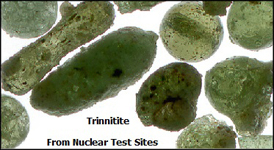
Trinitite, also known as atomsite or Alamogordo glass, is the name for the glassy residue left on the desert floor after the plutonium-based Trinity nuclear bomb test on July 16, 1945, near Alamogordo, New Mexico. The glass is primarily composed of arkosic sand composed of quartz grains and feldspar that was melted by the atomic blast. Trinitite is mildly radioactive but is safe to handle for short periods of time. (link)
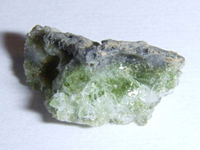
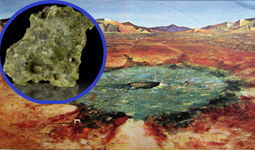
LEFT:Trinitite, also known as Atomsite or Desert Glass RIGHT: Nuclear glass formed at the test site in New Mexico (Alien Policy)
Colorful “cobblestones” at Ground Zero
“A fantastic landscape in Lower Manhattan — plummeting holes, steep cliffsides and soft billows of steel-gray bedrock, punctuated by thousands of beach-smooth cobblestones in a muted rainbow of reds and purples and greens.” (New York Times)
Thousands of “cobblestones” of various hues – reds, purples, and greens – were found at Ground Zero. These could be a type of “trinitite”, rock and sand turned into glass, that can be formed at the site of nuclear explosions.
Red trinitite
The typical green color of trinitite is caused by iron impurities, likely the result of the vaporized tower on which the device was positioned. Red trinitite like this is considerably more rare, and is associated with copper impurities from the cable runs that connected the device to the diagnostic and control trailers.
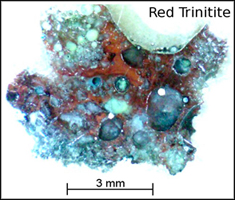
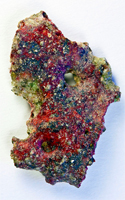
LEFT: Red trinitite (link) RIGHT: Red trinitite (link)
Red trinitite is found to the north of ground zero of the Trinity test. The red colour is due to the presence of copper in the glass. Close examination with the optical microscrope and scanning electron microscope reveals that this glass contains a number of metallic chondrules. Link
Perhaps the cobblestones resembled these samples of trinitite
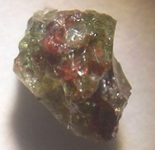

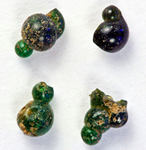
LEFT: Red-green trinitite – a variety of trinitite (Ant Hill Sand); CENTER: Trinitite with red streak and blue-green varieties (Ant Hill Sand) RIGHT: Spheres on spheres. Several examples of trinitite beads that ran into other beads and stuck together before fully solidifying and falling back to the ground. (link)
Green, red and black pebbles of glass were also found at the Trinity Test Site
On the sandy floor of the test site there are pieces of trinitite, blue-green pebbles of glass that were created when the bomb exploded. Some of the trinitite is also red or black, and contains copper or iron from the vaporized bomb and tower.
“The Geek Atlas: 128 Places where Science and Technology Come Alive” by John Graham-Cumming p.418 The Geek Atlas
Comparison between Hiroshima and World Trade Center bombings
Hiroshima |
World Trade Center |
Explosions were air burstsAir bursts tend to maximize the effects for a given yield. Hiroshima bomb was dropped by plane and detonated above the city.
No. 3 in this diagram
The bomb was dropped 576 meters above Hiroshima. The height the mushroom cloud reached is shown. |
Explosions were undergroundUnderground bursts reduce the effects (blast, thermal and radiation) of the explosion. The nuke was detonated in the basement levels of the WTC.
No. 2 in this diagram
Underground detonations produce a cavity and a subsidence crater |
Nuke was 15 kilotons
Diagram shows 15 kilotons of TNT. |
Nuke was <1 kiloton
Diagram shows truck carrying 1 kiloton of TNT. |
Weapon was a medium-sized nuke
‘Little Boy’, the bomb that was used on Hiroshima |
Weapon was a mini-nuke
Warhead of Davy Crockett nuke. It is one of the smallest nukes developed by the U.S. The yield is only 10 tons of TNT (0.01 kton). It can fit into a foot locker. |
Mushroom cloud was high and large
Coastline is outlined in this picture of Hiroshima (at the bottom) to show the magnitude of the mushroom cloud.
The mushroom cloud above Nagasaki |
Mushroom cloud was low and small
|
Bomb was dropped by planeand exploded in the air.
Enola Gay was the name of the bomber.
Bomb exploded in the air. |
Bomb was concealed in the basementand detonated underground.
Schema showing the hypothetical placement of the bombs. Both nukes and conventional bombs were used. |
No crater
Shima Hospital was at the hypocenter of the explosion. It was still standing after the bombing. |
Deep crater
The nuke created a gigantic pothole, 40 feet deep, carved into the rock under the WTC. |
Area of damage covered the city
In Hiroshima, the radius of destruction was 1 mile or 1.6 km. |
Area of damage covered a block
Buildings as far away as 150 meters were speared by heavy steel beams, such was the force of the explosion. |
Metal was twisted and bent
Mangled tangle of steel
This flange from a column supporting the Aioi Bridge was deformed by the powerful blast. It was 300 m from the hypocenter. |
Metal was twisted and bent
WTC steel recovered by NIST. Destruction of steel was a notable feature of the WTC disaster.
Steel beams were bent like pretzels due to the heat and force of the blast. Only something that can heat steel to 100,000s to millions of degrees Celsius can bend heavy and thick steel beams like this. |
Fused itemsEvidence of intense heat
Melted lunch box and ivory pipe 300 m from the hypocenter.
Tricycle: 1500 m from the hypocenter HiroshimaPeaceSite
Donated by Shuichi Morikawa This is a lump of electric wiring materials melted and fused by the high-temperature fire. URL: hiroshima.jp |
Fused itemsEvidence of intense heat. There was pools of molten metal months afterwards (NIST).
Melted and fused coins at the WTC Link
Fused metal and concrete
Detail of the above photo
WTC “meteorite” |
VaporizationOnly the shadow left behind
icpj.net Interface Council for Peace and Justice |
Vaporization
Only filing cabinet found at the WTC; there should have been hundreds to thousands. |
Disappearance of humans
Hiroka Nishimoto
Shadow of where a person sat on the steps of a bank building. Richard Seaman Fused lump containing human bones
These were exposed to the super-high-temperature fires. URL: hiroshima.jp |
Disappearance of humansThe remains of half the victims at the WTC have still not been found.
“There were 2,753 people killed in the New York City attacks after two passenger jets flew into the World Trade Center. But years on, more than 1,100 victims remain unidentified, with no trace of their remains ever found.” Star
“In September 2005 human remains were found on the roof.[4] In March 2006, construction workers who were removing toxic waste from the building before dismantling found more bone fragments and remains. This prompted calls from victims’ family members for another search of the building by forensic experts. Between April 7 and April 14, 2006, more than 700 human bone fragments were discovered in the ballast gravel on the roof. Workers sifted through the gravel to find more remains.” Wikipedia |
Blast forces
Donated by Fukoku Mutual Life Insurance Company The iron frame in the ceiling of the top floor of the seven-story Hiroshima Fukoku building was bent and sheared by the pressure of the blast. hiroshima.jp |
Blast forcesHeavy steel lattices landed 150 meters from the Towers and speared the corner of WFC3 building.
Heavy steel beam flung more than 150 meters from the Towers and became embedded in the World Financial Center 3 building.
World Financial Center 3 is across the street from WTC 1, and is the building with the cross in the upper left. |
Burned-out vehicles
Streetcar 320 meters from the hypocenter |
Burned-out vehicles
Burned-out vehicle near WTC 7 |
Evidence of ionizing radiation – cancers
All cancers including leukemia and solid cancers increased after the bombing.
Hiroshima survivor suffering acute effects of radiation |
Evidence of ionizing radiation – cancers
As of mid-2017, 6,000 WTC workers have cancer. This is 1 in 10 workers. Number of cancer cases has been increasing by 1,000 every year since 2012.
John Walcott came down with leukemia in 2003. Worked at Ground Zero and Fresh Kills. Many workers who worked in Fresh Kills landfill where debris was taken to also came down with cancer, indicating the debris and not the air was the main cause of the cancers. |
Abundance of dust
Vaporization of matter produced much dust |
Abundance of dust
Thick blanket of dust descended over NYC |
Reasons for use of tactical nukes – more details
Outlined here are the main reasons for the use of nukes
- To destroy the core of the towers. The core was highly resistant to destruction.
- To cause total destruction of the contents of the towers and the planes in order to hide the evidence that might be found on the planes, bodies of the passengers and in the towers.
- To simulate a gravity-driven collapse. One wave of collapse that swept through from top to bottom would look more like a gravity-driven collapse than a series of many smaller waves of collapses.
- To disguise the use of conventional ordnance in the collapses.
- To hide the bombs in the Towers better. Tactical nukes are compact in size: they give “more bang for the buck”, and therefore they can be hidden more easily in the buildings.
- To get around the need for stripping the building’s walls down to the steel beams and concrete. Nuclear munitions will destroy structures easily without needing to be in contact with surfaces, unlike many other munitions.

LEFT: Soviet RN-28 tactical nuke. Weight 250 kg; variable yield, from 1 to 10 kt. RIGHT: The equivalent of a 10-kiloton tactical nuke would require truckloads of bombs. Hiding this quantity of bombs in an office tower would be difficult.
Placement of tactical nuke in tower
The suggested placement of the tactical mini-nukes within the Towers (see illustration below). One mini-nuke was placed underground in the basement levels. Another nuke was placed about one-third of the way up. This one was probably of a very low yield compared to the basement one. The nukes were placed in this way to ensure the bombs would take out the core.
The core, that consisted of steel beams and reinforced concrete, were the hardest structures to destroy. To ensure complete destruction, nukes were used.
Nukes were considered for demolition purposes in civilian construction projects in the past. See Operation Plowshare.
Even the radiation effects of the nukes were thought to be containable if the bombs were buried deep underground.
In the WTC case, the basement levels would have been suitable places to locate the mini-nukes.
Unlike the case with a Hiroshima or Nagasaki-type bomb, the mushroom cloud, fireball and radius of destruction would be less obvious.
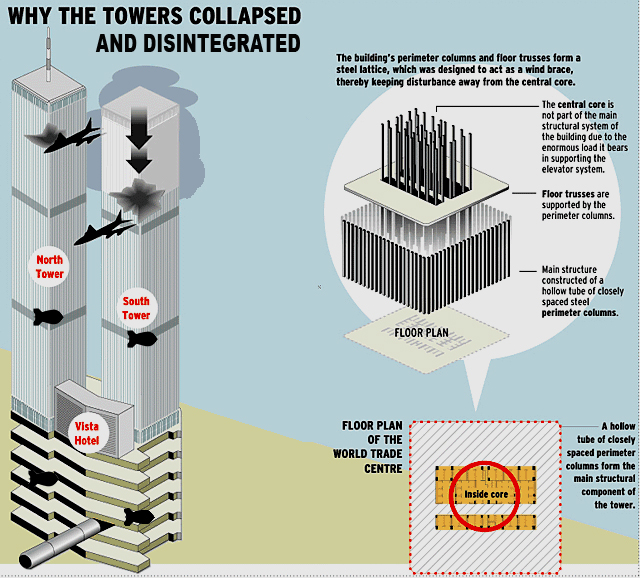
Suggested placement of the mini-nukes.
The Bathtub
The Bathtub acted as containment and shielding for the tactical nuke effects. It helped to camouflage the fact that nukes had been exploded to cause the towers’ fall and destruction. The seismic shock was also reduced, due to the ability of the Bathtub to act as a decoupling cavern.
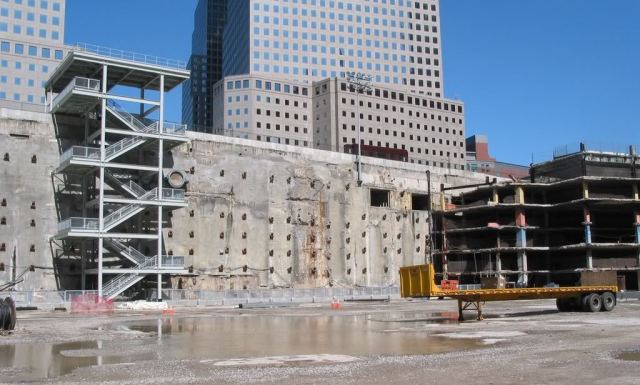
A view of the “Bathtub” after it has been washed down
The Bathtub was the solid bedrock on which the Towers were built, plus the slurry walls on the surrounding sides.
The six basement levels of the Towers resided within the Bathtub. The Bathtub acted as shielding for the bomb’s effects. It allowed the bomb to be “buried” underground. Thus, the blast, thermal and radiation effects were much less than if the bomb had not been placed in this way.
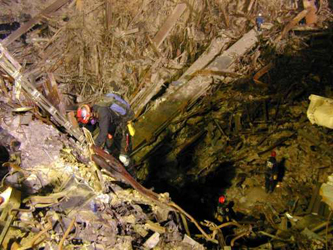
Responder climbing below the rubble into the cavern below
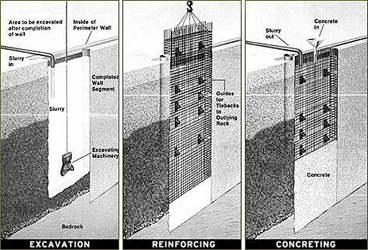
Construction of the slurry wall

“Bathtub”
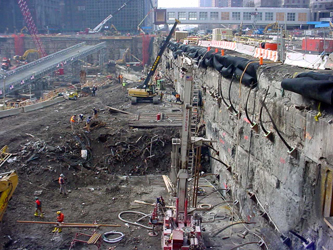
Another view of the “Bathtub”. There were six basement levels.

Schema of the Bathtub.
How was collateral damage reduced?

This was done by detonating the bomb underground. The shielding from the Bathtub, the bedrock, and the floors and walls of the basement levels greatly reduced the collateral damage, masking the fact that the explosions were nuclear in nature.
Size of the footprint
Footprint of a pancake collapse
The footprint of large-sized debris in a vertical straight-down pancake collapse should not have a radius much bigger than the radius of the building’s own footprint. And according to the official account, the towers fell vertically down on their footprint in a floor-by-floor pancake collapse: each floor progressively falling under the weight of the floors above it and the loss of supports underneath it.
The actual footprint, with a radius of at least 150 meters, is consistent with an explosion but not with a straight vertical pancake collapse.
Expected footprint
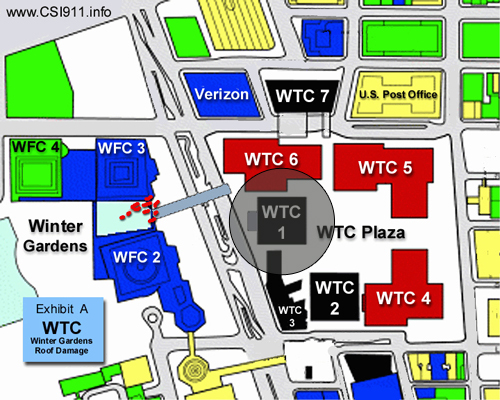
Estimated footprint in a pure pancake collapse.
Actual footprint
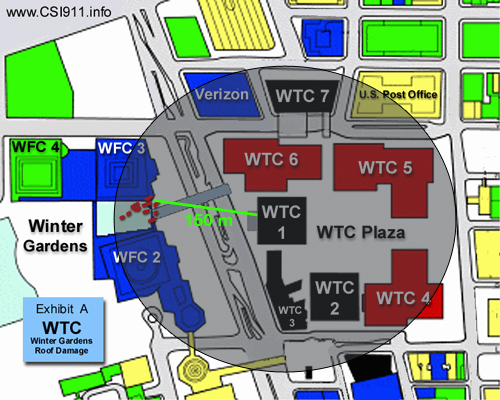
World Financial Center 2 and 3 and Winter Garden Atrium is shown. The distance between the WFC 3 and North Tower is 150 meters. The red dots show location of large-sized debris.
Such was the force of the explosion, steel lattices impaled a building 150 meters away
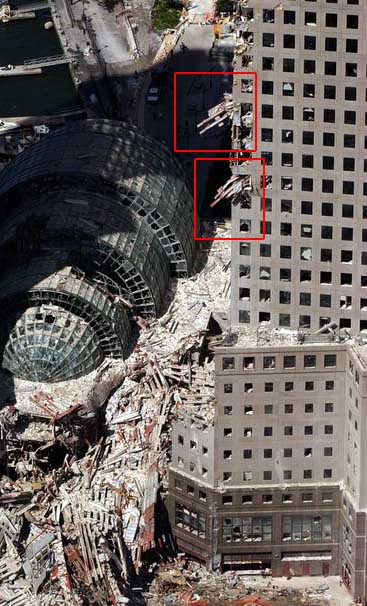
Steel lattices of the World Trade Center landed at the foot of World Financial Center Towers 2 and 3. Steel lattices also speared the WFC 3 Tower. WFC 3 is 150 meters from the North Tower.
Parts of the lattice speared the corner of the WFC 3, which means the lattice sections traveled 150 meters horizontally in the air. Powerful horizontal forces are absent in gravitational collapses. Thermite also does not cause such displacements.
In a nuclear explosion, the blast wave can throw objects far distances.
In addition, there are lateral translational forces are present.
These forces are measured in overpressures. High overpressures, as seen in nuclear explosions, can be the only explanation for this phenomenon. For more about overpressures, see this link.
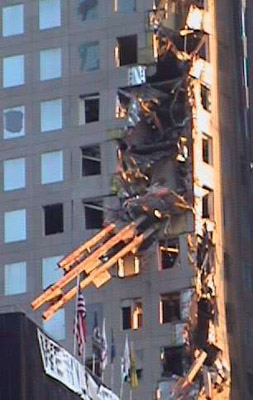
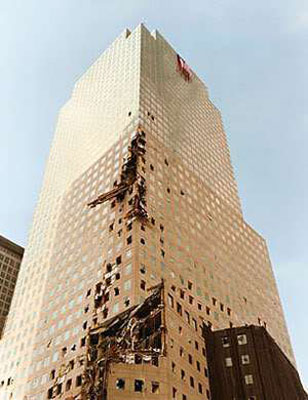
Close-up of the steel lattices embedded in the corner of the World Financial Center 3 Tower. The tower is 150 meters from the North Tower. See maps below.


The steel beam in the WFC3 building in picture above travelled 150 meters to spear the building’s facade. This does not happen in a pancake collapse. Such energy is seen in mini-nuke explosions.
Gravitational forces cannot produce this sort of phenomenon.
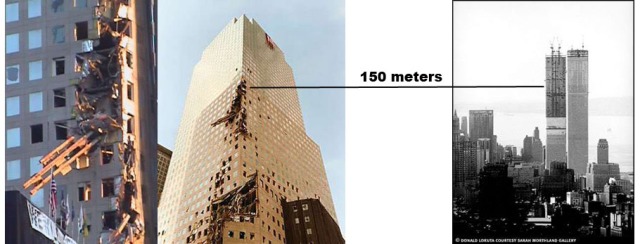
The heavy steel girders from the WTC tower flew a horizontal distance of 150 meters and embedded themselves into the World Financial Center Building 3. See map above.
Wintergarden Atrium Dome
The Wintergarden Atrium Dome was 150 meters from the North Tower, and was located between WFC 2 and WFC 3. The damage done to the Wintergarden Atrium Dome is evidence there were high overpressures involved in the blast wave at the WTC Towers.
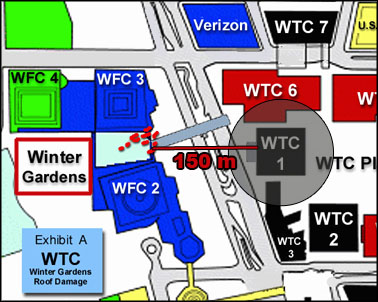

Wintergarden Atrium was 150 m from the North Tower.
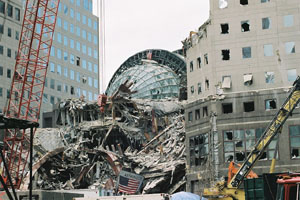
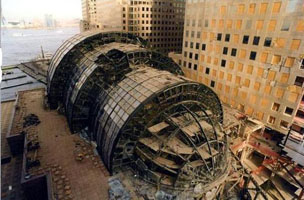
Collapsed Wintergarden Atrium Dome
Examining the picture below, the windows of the WFC 2 and 3 buildings have all been shattered. It is hard to understand how heavy debris reached this building 150 meters away from the nearest tower without concluding the heavy steel beams that weighed 30 tons were flung there by the blast wave of the nuclear explosion.
In a nuclear detonation, surrounding buildings of a hypocenter are affected by the effects of the explosion. The initial blast wave and translational forces that become hurricane force winds that travel 500 mph hurl objects, even heavy ones, far distances, and shatter windows of buildings for kilometers. Negative pressure that develops soon after the blast wave is generated also breaks windows in buildings far from the hypocenter.

Lattices that formed the skeleton for the periphery of the WTC.
The initial blast pressure is also responsible for breaking up the steel girders while they are in mid-air and throwing them for distances of more than 100 meters from the towers.
Embedded in the corner of the WFC3 are heavy steel lattices that were thrown like matchsticks by the force of the blast wave of the nuclear explosion.

Wintergarden Atrium Dome in detail. Heavy steel lattices of the Towers got blown more than 150 meters away.

Even though the towers were supposed to have collapsed on their footprint, large sized debris landed 150 meters away.
Overpressure of 20 psi and winds of 500 mph – consistent with a nuke
The blast wave and translational forces apparent in the WTC event, as shown by phenomena such as heavy steel girders doing severe damage to a building 150 meters from the nearest tower, indicates that overpressures of at least 20 psi (pounds per square inch) were present. This kind of overpressure is consistent with a nuclear blast. These overpressures produce high-velocity winds that cause heavy objects to fly large horizontal distances and land embedded in structures far from the hypocenter of the explosion. An overpressure of 20 psi can produce a wind of 500 mph. At this overpressure, reinforced concrete structures are destroyed.
Additionally, there are refractory wave forces (Mach wave) as well as negative pressures created in a nuclear explosion.
For more information about nuclear blasts and overpressure, see these two sites: Atomic Archive and Nuclear Warfare.
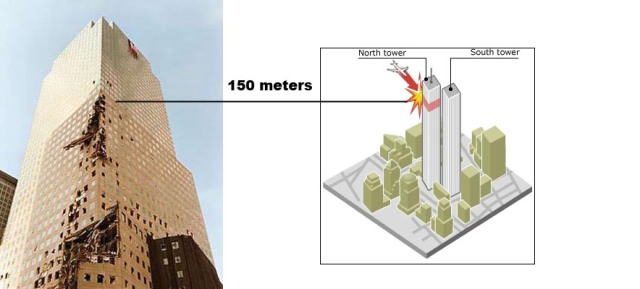
Gravity nor rebound forces from the plane striking the tower could have made the steel girders fly 150 meters distance and impale themselves into the corner of World Financial Center Building No. 3.
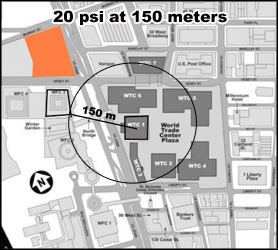
20 psi overpressure at 150 meters
| Overpressure | Physical Effects |
|---|---|
| 20 psi | Heavily built concrete buildings are severely damaged or demolished. |
| 10 psi | Reinforced concrete buildings are severely damaged or demolished. Most people are killed. |
| 5 psi | Most buildings collapse. Injuries are universal, fatalities are widespread. |
| 3 psi | Residential structures collapse. Serious injuries are common, fatalities may occur. |
| 1 psi | Window glass shatters Light injuries from fragments occur. |
From Atomic Archive
Underground bursts reduce above-ground radiation

Subsidence Crater Formation: Historic underground nuclear test causes the surface to subside which forms a crater. (Provided by the US Department of Energy under Public Domain rules.) Video.
Detonating a nuclear device underground reduces the effects of a nuclear explosion to some degree. The blast energy is absorbed by the earth. This will cause damage to underground structures but the power of the blast wave in the air will be reduced. A large proportion of the radiation will be trapped by the debris in the crater.
‘In this case a large part of the heat radiation and the immediate nuclear radiation is absorbed in the crater … produced by the explosion, and the surrounding buildings provide considerable shielding against the remainder …
A greater proportion of the radioactivity is trapped in the debris of the crater, mingling with the material which spills out around the crater and immediately downwind. This gives rise to a serious but more localised residual radiation hazard; the radioactive fall-out beyond is less widely distributed. glasstone
The concrete and steel core of the Towers
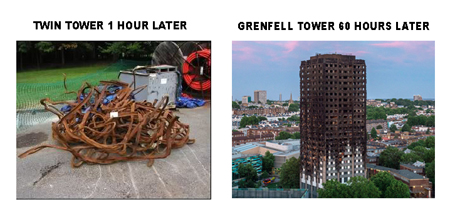
The core of the Twin Towers was built to withstand anything: earthquakes, great winds, even plane crashes. It was composed of steel and reinforced concrete. Even if the rest of the building fell away after being consumed by fire, the steel core was designed to be still standing, it was so strong. It had to be strong in order to keep the 110-story structure sturdy.
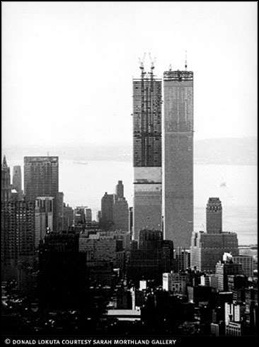
In this picture, the silhouette of the steel and reinforced concrete core of the Twin Tower stands out.
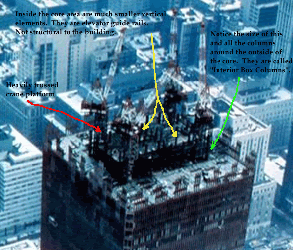
The engineering problem for the perps was how to take down the core.
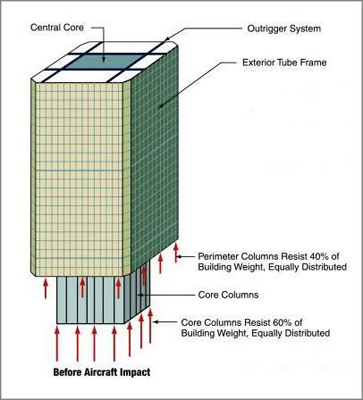
The tower’s core and perimeter.
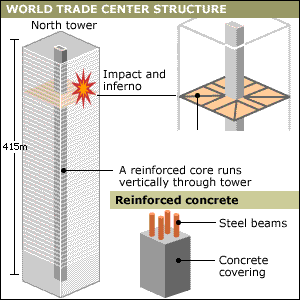
Illustration showing the core
Tactical nukes of low yield can destroy resistant steel cores
The yield can be as low as 0.01 ton (10 tons of TNT).
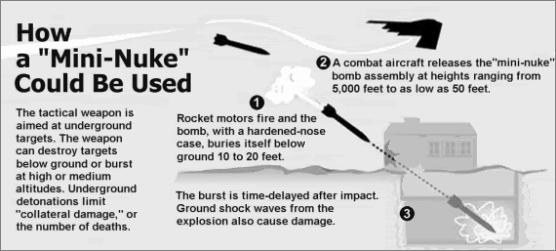
Nuclear bunker busters are considered tactical nukes because of their low yields. This diagram shows a 5-kiloton weapon. In this diagram, the mini-nuke is fired at the target. However, in the WTC’s case, the bomb would have simply been left in situ at the target site. Picture is from Federation of American Scientists
Grenfell Tower fire
The steel skeleton is the strongest part of any tower. Grenfell Tower was standing 60 hours after the fire started. It will probably stand until it is demolished.
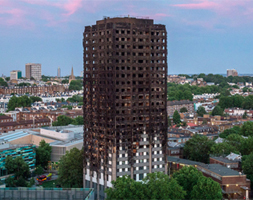
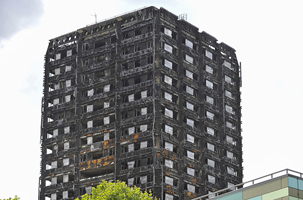
Grenfell Tower still standing after 60 hours. Yet the Twin Towers fell after just 1 hour.
September 11 was an engineering problem – how to destroy the core?
The Twin Towers only had two or three floors on fire after the fireball had burned itself out. The fires were small, and in the South Tower, they were about to be put out by the fire brigade with two hoses just before the collapse started. But it fell, less than an hour after it had been struck by a plane. The North Tower fell 1.5 hours after being hit by a plane.
Grenfell Tower in London had nearly all floors on fire. It was a 24 floor building. The fires raged for almost 3 days. But it was still standing 60 hours later.
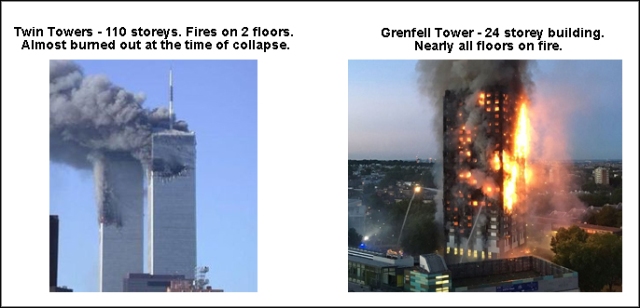
Twin Towers fell after 1 to 1.5 hours. Grenfell Tower still stood after being on fire for almost 3 days.
Problems with the thermite theory
Summary of problems with the thermite theory
The two main problems are that it needs to be applied directly to surfaces and it doesn’t destroy concrete.
- Thermite doesn’t destroy concrete – it’s a weak explosive, six pounds could not destroy or move a brick.
- Thermite has to be applied directly to surfaces – impossible to strip all the columns of the WTC down to bare metal surfaces.
- Thermite is an incendiary device – lots of flame is produced; the explosion of the towers was relatively flameless.
- Thermite doesn’t bend and twist steel – doesn’t generate high enough temperatures to do so.
- Since thermite is a weak explosive, large quantities of it must be brought into the towers – it would be impossible to conceal this amount.
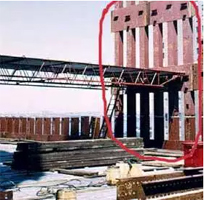
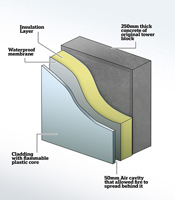
Metal would have to be stripped down to its bare surface and thermite applied to it for thermite to destroy the metal.
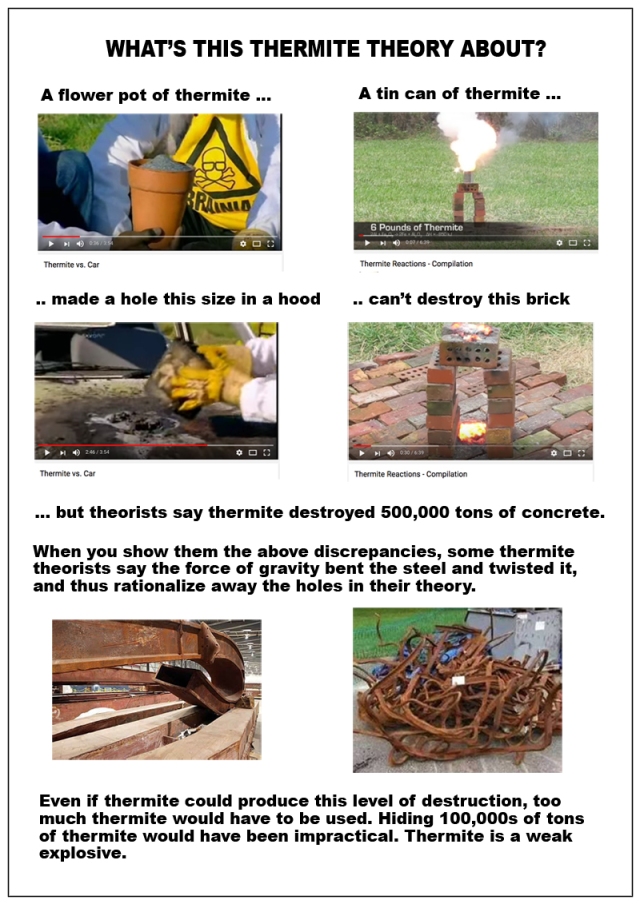
Video: Thermite experiment
VIDEO: Thermite Reactions – Compilation Youtube
In this experiment, a metal can containing 6 pounds of thermite was placed on a pile of bricks. Even though the metal tin can melted, the bricks were only burned but not dislodged from their positions.
This demonstrates that thermite has weak explosive properties. Some people do not classify thermite as an explosive for this reason. It is mainly used for cutting and welding metal. Thermite characteristically produces flames, and is used in incendiary devices (a weapon to start fires). The detonations at the tower were mostly flameless.
Each Twin Tower had about 500,000 tons of concrete. The amount of thermite needed to destroy all this concrete and turn it into powder would have been astronomical, considering that six pounds of thermite could not blast a brick.
Thermite may have been used as an adjunct in the demolition of the towers, but it had only a minor role, if it was used at all.
A tactical nuke would solve most of the problems of how to demolish a core made of steel and reinforced concrete.

A tin can of thermite (6 pounds) could not destroy a single brick. How much thermite would have been needed to crush 500,000 tons of concrete into fine particles? It would have been impractical to use 100,000s of tons of thermite to destroy the Twin Towers.
This ball of plutonium would have no problem doing the job of destroying a 110-story tower as well as turning 500,000 tons of concrete into dust.
A flower pot of thermite could only produce a small hole
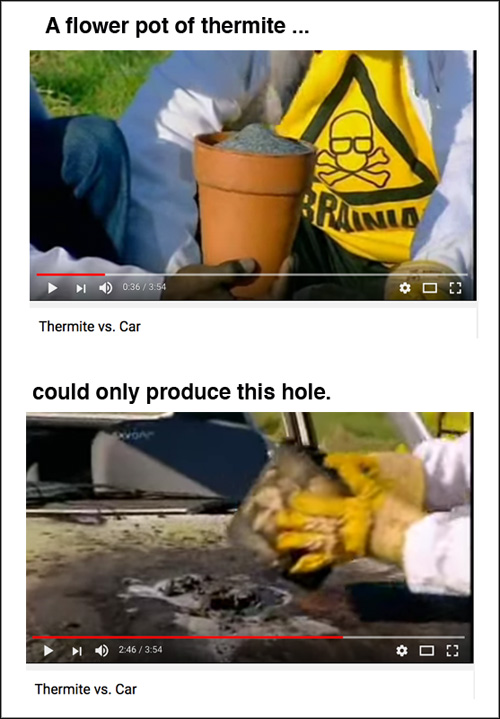
The damage done to the hood of a car after a flower pot of thermite was detonated over it. Scaling up, how much thermite would be needed to destroy thousands of tons of steel? Thermite would not be practical to use. Besides, it’s not powerful enough to bend steel.
Video: Thermite vs. car
VIDEO: Thermite vs. car Youtube
This is the sort of damage, the explosives did to the steel of the Twin Towers. Thermite could not have done this. The perpetrators would have had to use hundreds of thousands of tons of thermite, and still it would not have been powerful enough.

Damage done to the steel. Molten metal was found months after the incident.

Six pounds of plutonium can destroy a city block
Thermite needs direct application to bare surfaces
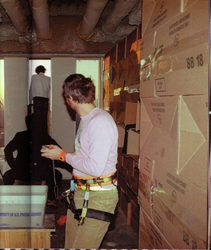

Israeli art students in the 90th floor of the North Tower doing construction work for an art project 6 months before September 11. (Read about the Gelatin E-team at the towers here)
Major construction work would have been required to strip the steel down to its bare surface on 110 floors, and so would have been impractical.
Also, the steel surfaces could not be accessed in many cases; for example, in the core. The steel there was surrounded by reinforced concrete.
Insufficient blast power generated–cannot throw heavy beams far horizontally
Thermite doesn’t have sufficient power to throw heavy steel beams far distances and impale them in buildings. High kinetic energy would have been needed. In a thermite experiment, six pounds of thermite was unable to displace a brick from its position. (VIDEO: Thermite Reactions – Compilation Youtube).
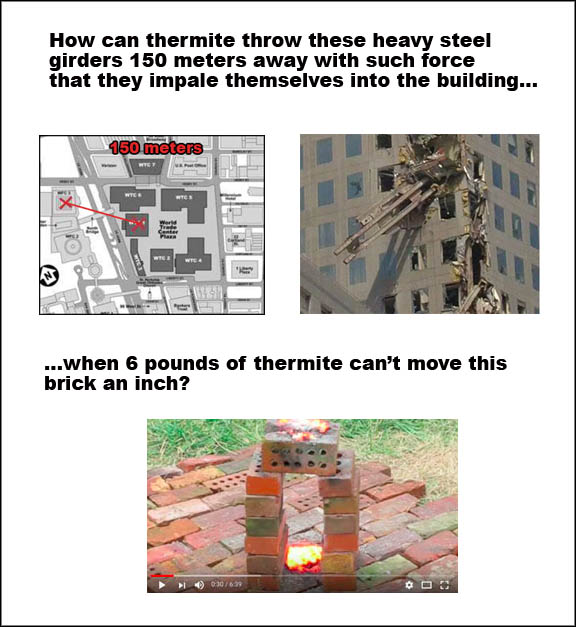
In the pictures below, heavy steel beams weighing many tons were flung 150 meters from the North Tower and were impaled in the World Financial Tower 3. Neither gravity nor thermite can do this.
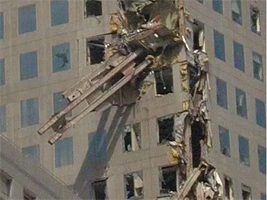
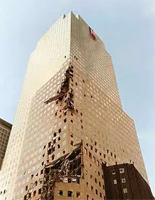


Beams from the Twin Towers speared the World Financial Tower 3 150 meters away.
Thermite too weak to bend steel beams
Many heavy steel beams were bent into pretzel and horseshoe shapes on September 11. Below are shown tridents that supported the periphery of the WTC tower at the ground level. Neither thermite nor ordinary explosives can do this.
But the thermal energy generated by a nuclear explosion is able to do this. Steel needs to be heated up by thousands of degrees Celsius to make them pliable enough to be bent like this.
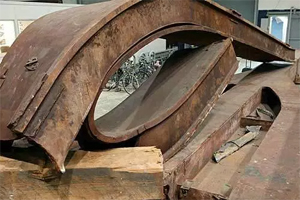
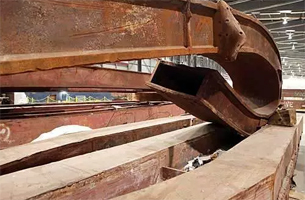
Tremendous heat is required to bend these huge beams into these shapes. Heat from ordinary building fires or a thermite explosion is insufficient to do this.
Theories compared
This table analyzes whether each theory fits the available evidence or not. For a theory to be credible, the theory must account for all the evidence available. If even one phenomenon observed in the event is not explained by the theory, the theory must be thrown out. Only nuclear weapons fit all the criteria. Other theories, including thermite and beam weapons, do not.
Nuclear weapon |
Thermite |
Directed energy weapon |
|
| Can cause cancer* in 1 in 10 workers (in 2017, 6,000 workers have cancer) | ✓ | ✗ | ✗ |
| Can cause early-onset mesothelioma (3 years, 5 years) | ✓ | ✗ | ✗ |
| Can throw 10-ton steel beams 150 meters out | ✓ | ✗ | ? |
| Can produce a giant crater 40 feet deep | ✓ | ✗ | ? |
| Can generate energy in the order of 180 million kWh to smash 500,000 tons of concrete into 0.3-micron particles | ✓ | ✗ | ? |
| Generates enough heat to produce molten metal that persists for months | ✓ | ✗ | ? |
| Can bend 10-ton steel beams into pretzel shapes | ✓ | ✗ | ? |
| Can toast cars >200 meters away | ✓ | ✗ | ? |
| Can make people disappear | ✓ | ✗ | ? |
| Can fuse objects together | ✓ | ✗ | ? |
| Can cause appearance of fission products at the site (strontium, barium, cesium, tritium) | ✓ | ✗ | ✗ |
| Can produce an overpressure of 20 psi at 150 meters from the hypocenter | ✓ | ✗ | ? |
*The cause must explain the high cancer rate of workers who worked only in Fresh Kills Landfill, which is far from the WTC complex.
Did a nuclear bunker buster fired from the plane punch a hole in the towers?
VIDEO: A View of Plane Impact in South Tower World Trade Center Youtube
Possible causes of molten metal in the photo that was seen shortly after plane impact
- Nuclear bunker buster fired from the plane
- Depleted uranium bunker buster fired from the plane
- Pre-planted explosive device (conventional or a micronuke) on a plane crash floor that was detonated soon after the impact of the plane with the tower.
- Thermite charges pre-planted in the plane crash floors (the least likely cause)
- A combination of the above.
Molten metal

Molten steel dripping down
The most likely cause for the molten metal seen in the picture is either a DU earth penetrator or a nuclear bunker buster fired from the plane, probably from the radome of the plane, and fired by a proximity fuze or a fuze with another type of sensor (radio, optical, acoustic, or magnetic).
The reason to suspect missiles is that something was needed that could punch a hole in the steel latticework of the periphery, through which the plane could enter. An ordinary missile would probably fail to do that, and a plane, with its soft aluminium nose cone, would almost certainly be unable to achieve that.
VIDEO: The Earth Penetrating Capability of The B61 12 Nuclear Bomb extract Youtube
A special missile required to breach Pentagon walls: the earth-penetrator
An earth-penetrator is a weapon that can reliably penetrate the limestone, metal mesh, reinforced concrete walls of the five-ring Pentagon, and smash through the steel latticework of the peripheral walls of the Towers. A nuclear bunker buster would be the best bet to slice through thick steel columns. Moreover, a large object was seen flying out from the other side. That was probably a missile part flying out, or the plane’s nose cone exiting through the hole that had previously been made by the missile.
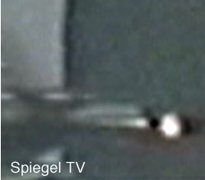
A flash of light at the nose of the plane before it hits the South Tower. Looks like a missile is being fired from the radome of the plane and the flash is from the tail of the missile.
It was important that the planes enter the buildings so that they could be blamed for the ensuing fires that were said to be caused by leaked jet fuel. The fires could then be blamed for the collapse of the towers.
Bunker buster/earth-penetrator breaches thick plane-crash resistant walls
Additionally, the evidence on the planes had to be completely destroyed.
The plane that crashed in Shanksville was probably armed with a bunker buster (depleted uranium or nuclear), in readiness to fire at some building. This was detonated shortly after the plane crashed, or just before it crashed, by remote control, to hide the evidence of the missile and the other evidence on the plane.
Two sets of nukes used: a nuke missile fired from a plane and underground basement nukes
Hence, it’s possible that there were two types of tactical nukes used in the attacks. One set were nukes that had been pre-planted in various locations inside the towers, including the basement levels, and the other set were to be fired from the planes.
Video: Bunker buster penetrating through many layers of concrete
VIDEO: GBU 28 ‘Bunker Buster’ Laser Guided Bomb Penetrating a Wall Youtube
While not a nuclear bunker buster, the principle of operation of the GBU 28 bunker buster is the same. The head of the bomb is made from hardened steel so that it can survive the plunge through many feet of soil and layers of concrete. Once the bomb has entered the bunker, an advanced electronic fuze sets off the warhead. New versions of this warhead have been in service since 1995.
Massive fireballs and ordnance flashes = a missile fired from the plane
Bunker busters could explain the appearance of massive fireballs shortly after the plane’s impact with the Towers, creating the dramatic scenes that were caught on camera. In the video below, the bunker buster destroys a hardened target, and a fireball is generated on the inner side of the target.
VIDEO: Bunker buster bomb Youtube
Why is it important to determine whether nukes were used or not?

Ziad Jarrah and Mohammed Atta
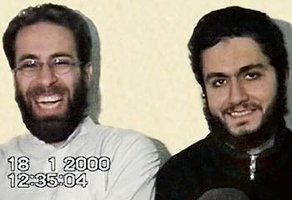


Narrows down possible suspects: Arab nations did not make nukes
It narrows down the field of culprits. If thermite is proven to be used, it doesn’t narrow down the field of possible culprits. Arab terrorists could have somehow introduced thermite into the buildings.
Many causes of molten metal and microscopic sized iron spherules, not just thermite
The mistake of many conspiracy theorists is that they limit the evidence they use to base their conclusions on. Instead of looking at all the evidence at hand, they tend to focus on the molten metal picture or the finding of microscopic iron spherules.
They decide that this is sufficient evidence to conclude that thermite was used.
However, there are other causes for these findings of molten metal and microscopic iron spherules.
Thermite leads you to the wrong culprit, and patsies end up being blamed
By narrowing the cause down to thermite, through ignoring other possibilities, and not fully knowing the properties of thermite, investigators reach the wrong conclusion that thermite was the main material used to destroy the towers.
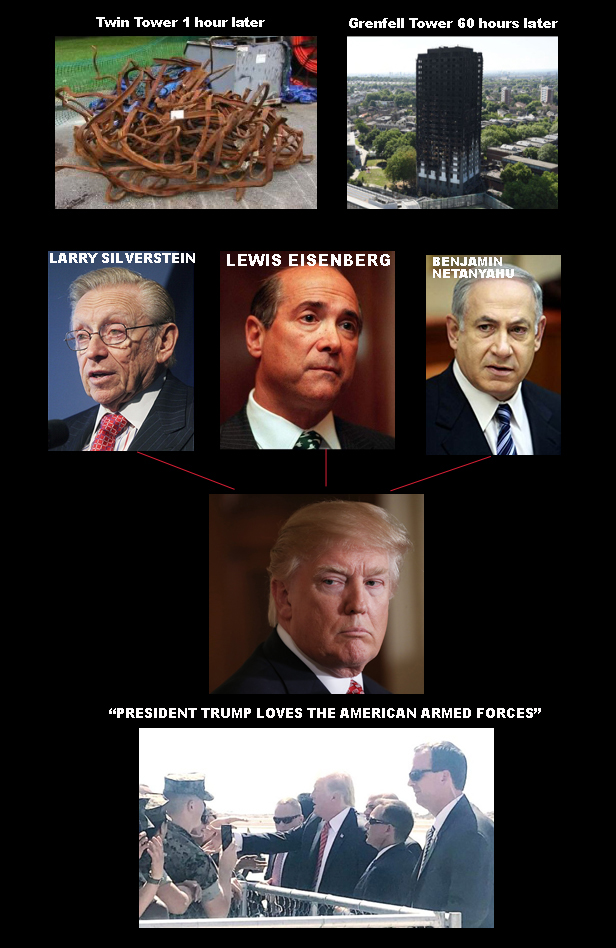
Ways thermite could have been involved in the towers’ destruction
There are these possibilities involved:
- Thermite was the main material used to destroy the towers.
- Nukes were the main material used to destroy the towers and thermite was not used.
- Nukes were the main material used to destroy the towers, and thermite was used to cut some steel joints.
Only nukes explain all the evidence: physical evidence, medical evidence, chemistry evidence
On the basis of all the evidence available, which includes the medical evidence of the cancers in workers, the physical evidence of the area and scope of destruction, and the chemical evidence of radioactive elements in the debris, the conclusion that can be drawn fits numbers 2 and 3.

Different features, such as the length of the nose, appear in these images.
Thermite cannot explain the medical evidence, physical and chemical evidence.
Once again, finding the correct cause is important so that the culprits are correctly identified.

In faked videos where an actor is impersonating someone, the images and film will be grainy, unclear and blurred. In contrast, when the real person appears in the film or in a photo, the images will be clear.
Thermite could have been obtained by Arab terrorists in 2001 or earlier. However, they would not have been able to obtain nuclear material.
Therefore, the conclusion that nukes were used means that Arab terrorists can be ruled out as the culprits. They were patsies.
Only countries that could produce nukes could have done it
Only state actors that have access to tactical nukes can be the culprits, which narrows down the field considerably.

“Bin Laden” in 2004 and 2007. Often the videos and images are grainy and unclear when actors impersonate a person and faking is done.
Cancers in workers and bystanders
Much of the following information is from the WTC Health Program. This program offers health care to those directly affected by the September 11th attacks.
Total cancer cases (responders and bystanders)
This is the number of cancer certificates (cancer diagnoses):
- In 2013: 1,100 (CNN)
- In 2014: 2,500 (link)
- In 2015: 3,204 (CDC)
- In 2016: 5,400 (CDC, CNN)
- In 2017: 6,893 (CDC)
Over 4 years, cancer cases increased by a factor of six
Between 2013 and 2017, the number of people with cancer increased 6x (from 1,100 to 6,893).

Graph made with statistics compiled from CDC, NY Post and CNN reports
More than 1,000 new cancer cases every year
The news below was reported in August, 2016 when 5,400 workers and bystanders had cancer. Just one year later, this information was outdated. In June 2017, the number of people who had worked or lived near the WTC site or other 9/11 sites with cancer was reported to be 6,893, an increase of approximately 1,400 people. Cancer has been increasing by 1,200-1,400 cases every year. Report: CNN
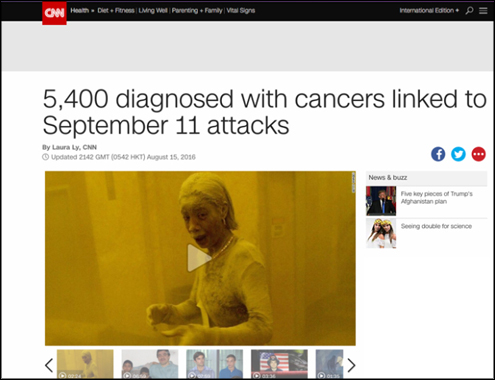
This news was reported in August, 2016 when 5,400 people had cancer after 9/11. The figure became quickly outdated. Article from CNN
The cancer total climbing rapidly
67,500 workers were enrolled in the program as of June 2017. 5,800 have cancer. 1,300 people have already died.

World Trade Center Health Program 2017 CDC
Mesothelioma less than 15 years after exposure is not asbestos-related
In what should sound an alarm, cases of mesothelioma (pleural lining cancer) occurring early have been reported in the media. An emergency worker died in 2006 of mesothelioma, five years after 9/11. Another emergency worker, Deborah Reeve, died of mesothelioma in 2004, three years after the September 11 attacks.
These are just the cases reported in the media; there could be other similar cases. Since it takes 20-50 years to develop mesothelioma after asbestos exposure, this rules out asbestos as the cause.
The only known cause for early mesothelioma is radiation. Air toxins do not cause mesothelioma. Only radiation can cause these workers’ cancer. Therefore, these cases of early mesothelioma are conclusive proof that radiation is the cause of their cancer. Radiation fits the medical as well as other kinds of evidence.
Emergency worker Deborah Reeve’s age of 41 years at death virtually eliminates the possibility that she was exposed to work-related asbestos when she was younger.
These diseases normally take between 20 and 50 years to display symptoms. But in 2006 – five years after inhaling the toxic debris from Ground Zero – an emergency responder from 9/11 died of mesothelioma. Another worker, 41-year-old Deborah Reeve, developed a serious cough just two years after the attacks and died of mesothelioma in 2004. asbestos.com/world-trade-center/
The above two cases of mesothelioma in WTC workers are the only ones reported in the media. There may be more. Mesothelioma is quite rare among those exposed to asbestos. In one study on asbestos and mesothelioma, it was reported:
the percentages of exposed people who develop mesothelioma are relatively low.
The fact that there are two known cases of early-onset mesothelioma in WTC responders (2 and 5 years) in a population of 60,000 workers should raise the alarm that there was ionizing radiation at WTC Ground Zero.
Summary of why asbestos did not cause the cancers in 9/11 workers but ionizing radiation did
SUMMARY OF WHY ASBESTOS AND MESOTHELIOMA THEORY IS WRONG
|
More about latency period and mesothelioma:
2/ Study of asbestos and mesothelioma
The latency periods observed in the present mesotheliomas showed extreme variations, from 25 to 68 years. The mean latency period was superimposable to that observed in large series of mesotheliomas among shipyard workers in the Trieste-Monfalcone area. [18]
Ionizing radiation causes early-onset mesothelioma and other types of lung cancer
|
The black star shows the tracks made over a 48 hour period by alpha rays emitted from a radioactive particle of plutonium lodged in the lung tissue of an ape (the particle itself is invisible). In living lung tissue, if one of the cells adjacent to the particle is damaged in a certain way, it can become a cancer cell later on, spreading rapidly through the lung, causing almost certain death. Photo by Robert Del Tredici from his book entitled At Work In The Fields Of The Bomb (Harper and Row, 1987) |
Ionizing radiation, such as the radiation emitted by the debris of the WTC towers, can cause mesothelioma. It can cause early-onset mesothelioma, which asbestos never does. It can cause unusual mesotheliomas, such as mesothelioma of the peritoneum, which asbestos never does. The mesotheliomas can be highly aggressive. Ionizing radiation can cause many other types of lung cancer, not just mesothelioma. Mesothelioma is an extremely rare cancer compared to other types of cancer.
More about radiation and lung: Lung cancer and exposure to ionizing radiation
“… in 2006 – five years after inhaling the toxic debris from Ground Zero – an emergency responder from 9/11 died of mesothelioma. Another worker, 41-year-old Deborah Reeve, developed a serious cough just two years after the attacks and died of mesothelioma in 2004.”
Mesothelioma is a well-known complication of radiation therapy for cancers
Patients receiving radiotherapy can get mesothelioma in the lungs or in other places, depending on what part of the body the radiotherapy treatment was aimed at.
More about ionizing radiation and mesothelioma here.
We can even estimate the dose of radiation left at the towers after the event
From this table, it can be seen that workers were exposed to at least 1000 mSv of radiation. In the table, it says 1 in 20 people will develop cancer when exposed to 1000 mSv of cumulative radiation. 1 in 10 WTC workers have cancer as of 2017, so the workers were exposed to a minimum 1000 mSv of radiation. This amount of radiation at a site is consistent with the detonation of a nuclear device.

From: World Nuclear Association
The dose of radiation WTC workers received was 8 times greater than the dose Chernobyl workers received during the clean up
This dose, 1000 mSv, is greater than the dose of radiation that Chernobyl workers received during their work of cleaning up after the meltdown (liquidators). The workers received an estimated average dose of 165 mSv. This means that the WTC workers (and the Fresh Kills workers) were exposed to more than eight times the radiation that Chernobyl workers received when they worked at the disaster zone, cleaning up and trying to contain it.
It can be predicted that the incidence of cancers in WTC and Fresh Kills landfill workers will rise. Currently, it is 1 in 10 workers (6,000 out of a total population of 60,000 workers) who have cancer.
|
These workers received an estimated average dose of 165 millisieverts |
Responders had many kinds of cancers, including rare ones; even childhood cancers – ionizing radiation can cause all of these
A wide variety of cancers appear in the people exposed, including rare cancers. Workers are being denied coverage for their rare cancers as the cancers are not linked to airborne toxins in studies.
Responders worked in the hypocenter right after the attacks. These people would have received a high-dose of radiation, and were completely unprotected from the alpha, beta and gamma rays that were being emitted from the dust and debris.
The cancer profile of September 11 responders matches the cancer profile of survivors in the Hiroshima bombing.

Top 15 cancers in the World Trade Center Health Program 2017 CDC
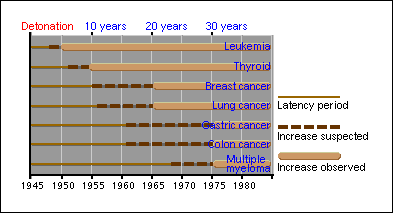
Source: Effects of A-bomb Radiation on the Human Body 1992,
Ed. Hiroshima International Council for Medical Care of the Radiation-exposed, Bunkodo (pcf.city.hiroshima)
In Hiroshima, common cancers were thyroid, breast, lung, and salivary gland cancer. Leukemia and thyroid cancer appeared the earliest. Leukemia started showing up 5 years after the bombing.
Leukemia
The latency period for leukemia is 5 years. Therefore, it was the first cancer to appear after the Japanese bombings. For solid tumors, the latency period is a little longer – at least 10 years. (NCBI-NIH).
The incidence of leukemias is related to the dose of radiation. The higher the dose, the higher the incidence.
Note: “High-dose” means 1 Sievert or more. (Reference: A-bomb Radiation Effects Digest 1992)
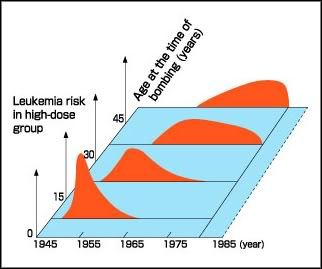
Age and leukemia risk in high-dose (> 1 Sievert) group. Note that leukemia appears earlier the younger the age of the person. (pcf.city.hiroshima)
16 years after the September 11 attacks, there were 247 cases of leukemia among the workers and bystanders. (CDC).
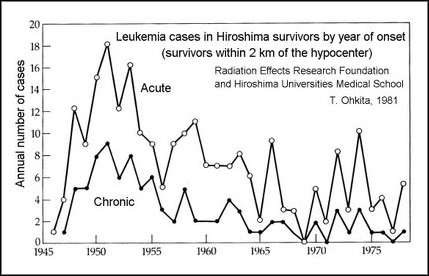
Number of leukemia cases in Hiroshima survivors (Glasstone)

Rate of leukemia in Hiroshima-Nagasaki survivors and other cancers compared to controls (from 1950-78) Glasstone
News headlines track the alarming increase: 2017 – now one in 10 workers
In 2013: “More than 1,100 have cancer after 9/11”
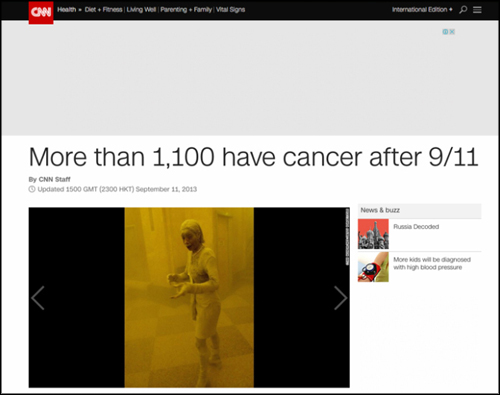
In 2014: “2,500 Ground Zero workers have cancer”

In 2016: “Diagnoses of 9/11-linked cancers have tripled in less than 3 years”
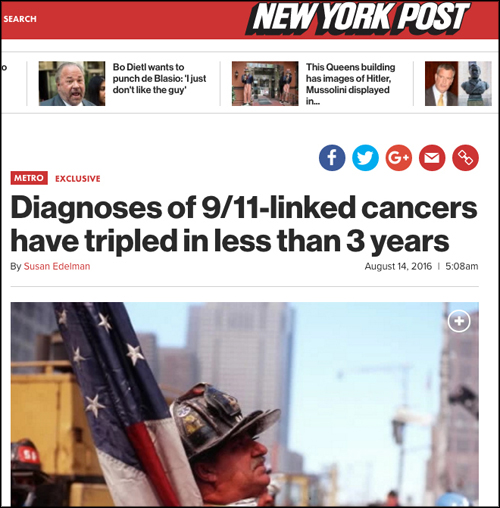
2015: “EXCLUSIVE: State judge denies workers’ compensation claim brought by ASPCA animal rescuer dying from 9/11-related cancer”
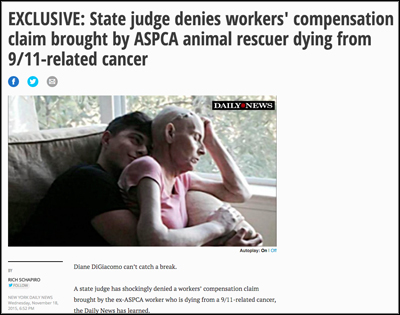
2016: “Endless Attack: Sick 9/11 Responders Still Struggle to Get By”

2014: “9/11 responders with rare cancer denied insurance coverage”
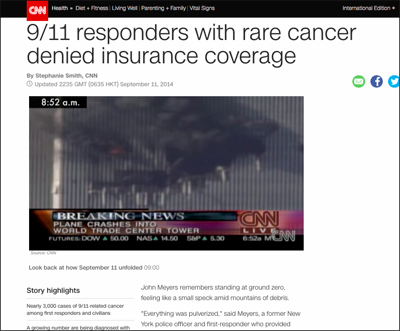
2016: “9/11’s second wave: Cancer and other diseases linked to the 2001 attacks are surging”
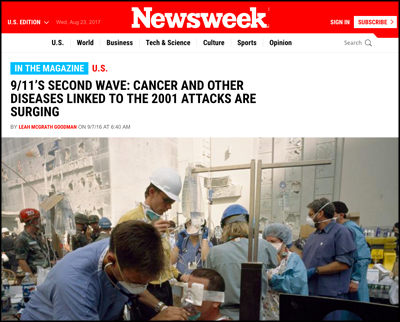
2017: “FDNY Firefighter Michael Duffy Dies of 9/11-Linked Cancer”
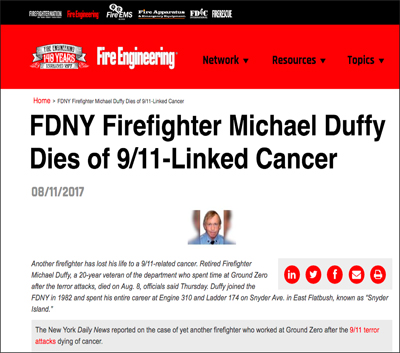
2017: “‘Heroic’ Retired NYPD Cop Dies from 9/11-Linked Cancer”
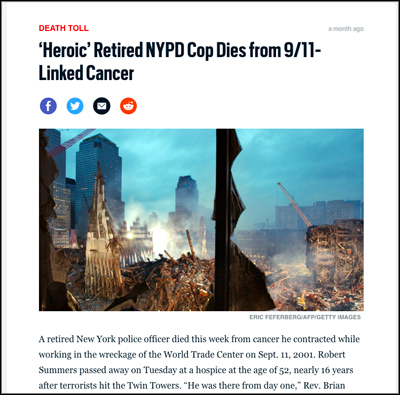
2017: “Father and son 9/11 first responders die less than a year apart from cancer linked to 9/11 recovery”
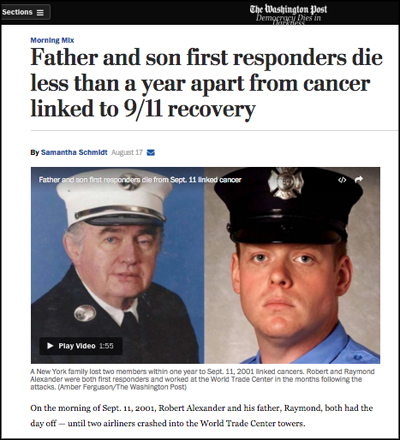
Attempts to clean up the radiation unsuccessful as cancer victims are living walking proof towers were nuked
Decontamination efforts began almost immediately after the nuking events. The next day, cleaning companies (including Interclean) came in and poured 20 million liters of water into the Bathtub. Cleaning stations were set up around entry and exit points around Ground Zero to wash the dust off vehicles. The streets around Ground Zero were hosed down until the roads were shining.


Cleaning stations to remove dust from cars were set up straightaway. Decontamination procedures began the day after the nuking.
All debris was removed–taken to Fresh Kills. Most of the steel beams were exported to China as scrap metal. They were tagged with electronic sensors to track their movements. This was to ensure that they left the USA and reached China. A few steel beams were kept in a museum about 9/11–a converted airplane hangar. And a few others were sent to NIST for examination.


LEFT: Trucks moved debris and dirt out and moved clean dirt in. Steel had electronic tracking devices attached to them. RIGHT: Fresh Kills landfill on Staten Island where much of the debris was taken to
After all the debris from the WTC site, including the dirt, had been removed, clean dirt was trucked in. Thousands of tons of this dirt was dumped in Ground Zero. Soil is known to “dampen down” radiation and reduce levels in the atmosphere.
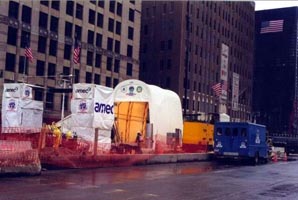
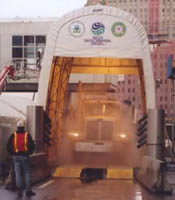
Hosing off radioactive dust from vehicles was important in the decontamination process
The washing of vehicles continued; the aim was to wash away the dust into the drains, away from the surface. All the dust was radioactive. This was mainly concrete dust, all that was left after the towers had been atomized by the nukes and conventional bombs.
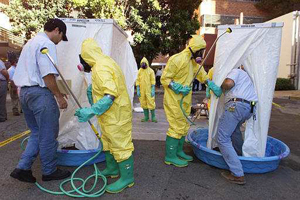
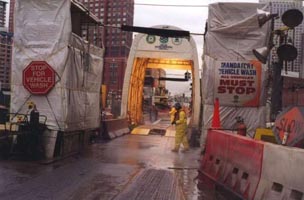
Dust was blown off from people with air pressure. Note the cleaning crew are equipped with Hazmat suits and masks but the other workers are not.
Even though the decontamination efforts seemed to be successful, the ionizing radiation could not be hidden. Responders (police officers, fire fighters, paramedics, debris-removal workers, disaster workers) and anyone within close vicinity of the towers or at the site at the time of the nukings and during the months afterwards had already been exposed to the radiation from the debris, and many had developed cancer. These cancer patients are walking evidence that the towers had been nuked.
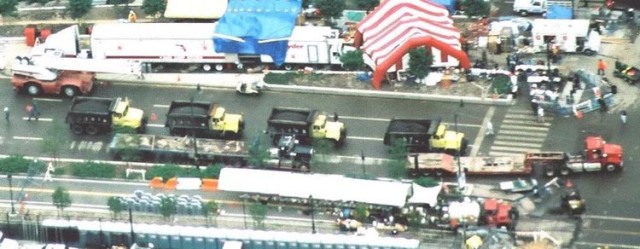
Clean dirt trucked in
If their urine samples had been collected at the time, they would have shown radioactive elements.
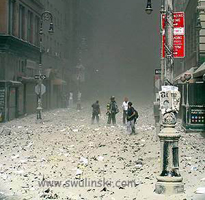

Dust and debris strewn streets became this: clean hosed-down streets with all dust removed
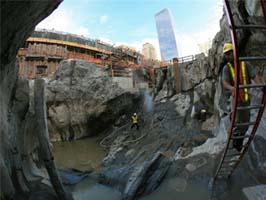
The basement was flooded with water and all soil was removed
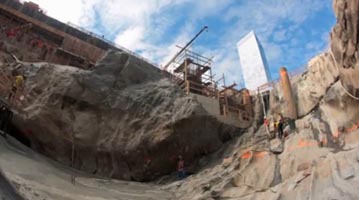
The dirt was completely removed from the WTC site to remove the incriminating evidence
So, while the decontamination efforts have reduced the evidence at the environmental level–radioactive debris has been removed from the site, radioactive dust has been washed away–and radiation cannot be detected now at Ground Zero, the proof is in the WTC workers. Their high rates of cancer (1 in 10 have cancer as of 2017) attest to the fact that a nuking happened at the WTC. There is no other explanation for this cancer spike among WTC workers.
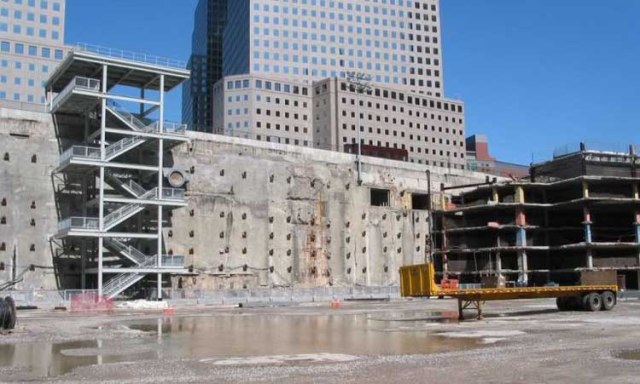
The result: washed down-Bathtub
Read more about the decontamination efforts here.
Tactical nukes can be smuggled in easily
Suitcase nuke
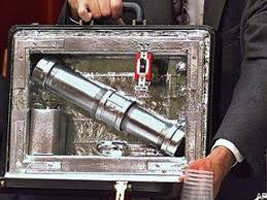
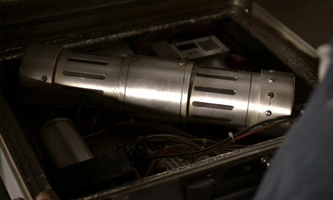
LEFT: Mockup of suitcase nuke RIGHT: Suitcase nuke
W54 Special Atomic Demolition Munition (SADM) was produced in the United States until 1988. The W54 was a small (0.01 to 1 kiloton) suitcase nuke with the entire unit weighing in at under 163 pounds.
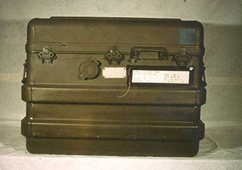
Suitcase nuke
Easy to transport suitcase nukes into the USA
Several Russians have reported that after the fall of the communist regime in the Soviet bloc, mininukes (or “suitcase nukes”) were smuggled out of the Soviet Union and sold on the black market. There are also reports that they entered the USA via the Mexican border. Transporting mininukes into the US was a relatively easy thing to do according to these reports.
Lunev asserted that some of the hidden caches could contain portable tactical nuclear weapons known as RA-115 “suitcase bombs”. Such bombs have been prepared to assassinate US leaders in the event of war, according to him. Lunev states that he had personally looked for hiding places for weapons caches in the Shenandoah Valley area and that “it is surprisingly easy to smuggle nuclear weapons into the US, either across the Mexican border or using a small transport missile that can slip undetected when launched from a Russian airplane.
US Congressman Curt Weldon supported claims by Lunev but noted that Lunev had “exaggerated things”, according to the FBI. Searches of the areas identified by Lunev — who admits he never planted any weapons in the US — have been conducted, “but law-enforcement officials have never found such weapons caches, with or without portable nuclear weapons.”
Stanislav Lunev. Through the Eyes of the Enemy: The Autobiography of Stanislav Lunev, Regnery Publishing, Inc., 1998. ISBN 0-89526-390-4
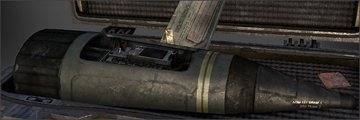
Suitcase nuclear device
VIDEO: Air Mossad takes off from Atlanta Youtube
Popular media often show large nuclear detonations

1) Fireball 2) Mushroom cloud 3) Winds and overpressures 4) Firestorm
Spectacular effects seen with megaton bombs, but not with mini-nukes
Spectacular effects such as a giant fireball, gigantic mushroom cloud and a widespread firestorm are often shown in depictions of nuclear explosions. However, these sorts of effects won’t be seen in underground detonations of low-yield tactical nukes. Instead, they will mimic the detonations of large-yield conventional bombs.
Many people are exposed to videos like the ones below. They may think that all nuke bombings are similar – spectacular affairs. However, this is not always the case. The bomb in the video below is 800 kt. Compare this to the estimated size of the bombs used in the 9/11 attacks: less than 3 kilotons. Also, the bomb is detonated above New York City, not buried underground or shielded within the walls of a tower.
What if a Bomb hit NYC?
Link: Youtube
Mini-nuke explosions are rarely discussed
Discussions about mini-nukes are rare except for bunker busters. Small nuclear bombs (10 tons) will produce different effects from large bombs (50 megaton Tsar Bomba).
Factors that determine the type of explosions (size and height of the mushroom cloud, size of the fireball, the area and extent of damage) are:
- Type of burst: below ground, above ground
- Yield of the bomb
- Height of the detonation. For air bursts, the higher the burst the greater the effects in general.
Compare sizes of mushroom clouds–tactical nuke vs. “atomic bomb”
The detonation of a tactical nuke will produce a tiny mushroom cloud compared to the mushroom cloud of Hiroshima.
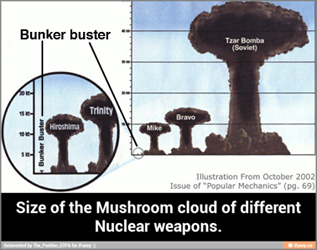
Diagram comparing the size of the mushroom clouds.
Comparing explosions: micro-nuke vs. “atomic bomb”
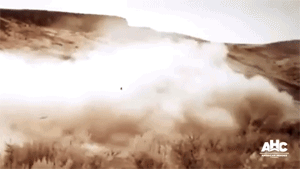
World’s smallest nuke being fired (video)
vs

Hiroshima-type atomic bomb tests in 1946 (video)
Disaster scenarios: megaton bombs, not underground mini-nukes
Note that the detonation of an 800 kt nuclear weapon is being described in the scenario below. It is detonated at an altitude suited to destroy a city.
From thebulletin:
|
25 FEBRUARY 2015 What would happen if an 800-kiloton nuclear warhead detonated above midtown Manhattan?Steven Starr, Lynn Eden, Theodore A. Postol Russian intercontinental ballistic missiles are believed to carry a total of approximately 1,000 strategic nuclear warheads that can hit the US less than 30 minutes after being launched. Of this total, about 700 warheads are rated at 800 kilotons; that is, each has the explosive power of 800,000 tons of TNT. … (cont.) Read more: thebulletin |
Types of bursts
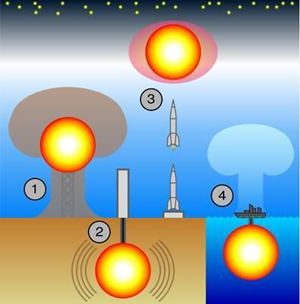
1. a. Surface burst b. Atmospheric burst 2. Subsurface (underground) burst 3. High altitude, air or upper-atmospheric burst 4. Underwater burst [Diagram: Wikimedia Commons: Types of nuclear testing]
Bursts can be classified in different ways:
Classification of bursts
- Air burst
- Surface burst
- Subsurface (underground) burst
- High altitude burst
- Underwater burst
Underground burst
The type of burst involved in the WTC attacks was mainly subsurface/ underground burst. A crater will result from an underground burst. If no penetration of the surface occurs, the main hazard will be ground shock.
But if the burst is shallow enough to penetrate the surface, blast, thermal and radiation effects. These effects will be less than those for an air burst of the same yield.
In underground bursts, if the surface of the ground is penetrated, local fallout will be very heavy.
In this type of burst, soil and debris are lifted into the atmosphere and fallout is concentrated above Ground Zero.
In the WTC attacks, the surface was penetrated, and so many responders and bystanders were exposed to intense local fallout. This explains the high rate of cancer among these people (see below).
|
Types of Bursts. The relative effects of blast, heat, and nuclear radiation will largely be determined by the altitude at which the weapon is detonated. Nuclear explosions are generally classified as air bursts, surface bursts, subsurface bursts, or high altitude bursts. a. Air Bursts. An air burst is an explosion in which a weapon is detonated in air at an altitude below 30 km but at sufficient height that the fireball does … (cont.) Read more at: FAS: Effects of Nuclear Explosions |
Difference between above-ground mini-nuke and WTC/underground nuke
Where the nuke is detonated can make a difference. Although an underground mini-nuke is the same size as an above-ground mini-nuke, the explosions can be different. The above-ground mini-nuke shows the same characteristics as a conventional nuke exploded in the air, eg, Hiroshima.
 vs
vs 
LEFT: World’s smallest nuke (Davy Crockett) being fired – a 10-ton explosion (video). This shows the typical mushroom cloud with a stalk. There is also a prominent fireball or a gigantic flash of light. RIGHT: Underground nuke test
Comparison chart of above-ground mini-nuke and underground mini-nuke
Above-ground mini-nuke |
WTC/Underground nuke |
|
| Size of bomb | Can be less than 1 kton | Can be less 1 kton |
| Fireball | Visible | Usually not visible |
| Crater | None or a shallow crater | Crater, giant pothole or underground cavity |
| Mushroom cloud | Mushroom cloud with a stalk | Smaller ones hugging the ground |
| Debris pattern | Debris scattered far and wide | Earth and other debris thrown up in air, thrown far wide |
| Surge clouds | Small ones | Seen, prominent |
| Aim | Destroy a structure (building) or to kill enemy combatants | Demolition a building, mountain, underground military facility |
| Conventional bombs used | Yes, can be used together | Yes, can be used together |
| Cancer | Yes | Yes |
 vs.
vs. 
Nukes were considered for use in peaceful demolitions
Nukes can be made to produce little radiation
A still from a film introducing Operation Plowshare to the public
Nuking for peaceful purposes such as construction work was considered by the US Government at one time (although the program was abandoned later due to health effects considerations), and many tests were performed, starting in 1960. This was Operation Plowshare or Plowshare Program (“Atoms for Peace”).
Uses of peaceful nukes–destroy structures
Uses for these “peaceful nukes” included:
- clearing a path through mountains for building of roads
- building a harbor
- widening a canal
- blasting underground caverns for water, natural gas and petroleum storage
- mining

One of the Chariot schemes involved chaining five thermonuclear devices to create the artificial harbor. Dept of Energy image.
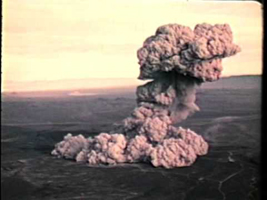
The Schooner Event was part of the Plowshare Program. Video.
Rulison test site. Underground detonation Click on image or here to see the image in detail (Diagram from stanford.edu)
Chagan test
Chagan was an underwater detonation the Soviet Union’s Peaceful Nuclear Explosions program, modeled on the American program. It was done to investigate the earth-moving effects of nuclear explosions for civil construction purposes.
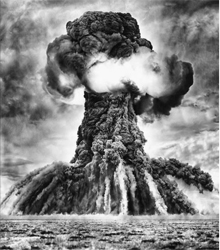
Russian test: Chagan (140 kt; underwater). This resembles the detonations of the Twin Towers. Large mushroom cloud at top, a column underneath it, and streamers shooting out at the base.
Project Gnome
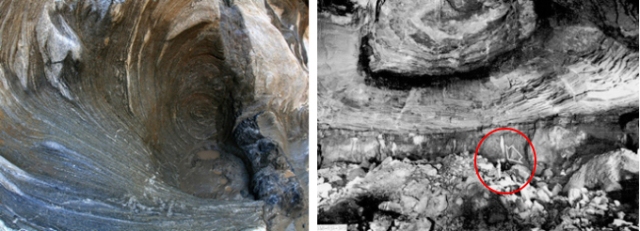
The “pothole” that appeared after the event at the WTC site. On the right is a picture from the cavity created after the Gnome Test. Inside the red circle is a man walking. This shows the size of the cavity.
Project Gnome (New Mexico) was a test in the Plowshare Program. It involved exploding a 3.1 kton nuclear bomb 361 meters underground in a salt deposit. This resulted in a large rock cavity.
It was believed that burying the explosion deep underground would reduce the release of radiation to acceptable levels. However, significant amounts of radiation escaped in these tests and the Plowshare project was abandoned 11 years later.
Similarity between cavities: Project Gnome and WTC–both in rocks
These operations show that it is possible to reduce radiation levels from a nuclear explosion by a significant degree. If the size of the weapon is small, and the device is placed deep enough, and the explosion does not penetrate the surface, leakage of radiation to the outside can be minimized.

On the left, a worker stands inside the red circle. On the right, a man stands inside the red circle.
Operation Plowshare nuclear tests
The tests listed here are of low yield (0.37 to 3 kt) and were done underground, and were conducted to assess demolition and other earth-moving applications of nuclear explosions. These explosions would have been similar to the ones at the WTC Towers.
|
Test name |
Type of test |
Objective |
|
Gnome (3 kt) |
New Mexico (1961), shaft, 361 m burial, salt |
A multipurpose experiment designed to provide data re: (1) heat generated from a nuclear explosion; (2) isotopes production; (3) neutron physics; (4) seismic measurements in a salt medium; and (5) design data for developing nuclear devices specifically for peaceful uses. |
|
Tornillo (0.38 kt) |
Nevada Test Site (1963), shaft, 149 m burial, alluvium |
A device-development experiment to produce a clean nuclear explosive for excavation applications. |
|
Sulky (0.9 kt) |
Nevada Test Site (1964), shaft, 27.4 m burial, basalt |
An excavation experiment to explore cratering mechanics in hard, dry rock and study dispersion patterns of airborne radionuclides released under these conditions. |
|
Templar (0.37 kt) |
Nevada Test Site (1966), shaft, 150.9 m burial, tuff |
To develop an improved nuclear explosive for excavation applications. |
|
Saxon (1.2 kt) |
Nevada Test Site (1966), 153 m burial, tuff |
A device-development experiment to improve nuclear explosives for excavation applications. |
|
Simms (2.3 kt) |
Nevada Test Site (1966), shaft, 190.1 m burial, alluvium |
A device-development experiment to evaluate clean nuclear explosives for excavation applications. |
GIFs of Operation Plowshare tests
These gifs are taken from the video of Plowshare tests called Operation Plowshare: “Project Dugout” 1964 Lawrence Radiation Laboratory AEC.
Being underground tests, they show how underground tests differ from atmospheric detonations. There is an absence of fireballs or large mushroom clouds in these tests.
Streamers and plumes are prominent in underground explosions
Plumes and streamers of debris and dust shoot out from the center of the explosion. The phenomenon resembles the eruption of a volcano. The dust often consists of soil particles.

Dirt and particularized debris is thrown up and descends in streamers and plumes.
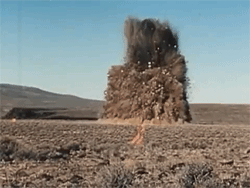
Underground nukes have smaller mushroom clouds than “atomic bombs”
Because the explosion is buried underground, the typical large mushroom cloud is not seen.

No fireball with underground nukes
Since the explosion occurs underground, the fireball is usually not visible, although occasionally flashes of fire can be seen in the mushroom cloud.
The glow from the fireball can sometimes be seen.
A lot of dirt is thrown out as the soil is displaced by the force of the explosion. The ground is lifted up.

Surge clouds are prominent with underground nukes
These are clouds that appear close to the ground spreading out from the base of an explosion.

Surge clouds can be seen spreading outwards while hugging the ground.

Comparison of Hiroshima type nuke and underground mini-nuke
Hiroshima |
Underground mini-nuke |
|
| Size of bomb | 15 kton | Can be <1 kton |
| Type of detonation | High in air, over city | Underground, in basement of building, in an underground cave |
| Fireball | Visible | Not visible |
| Crater | No | Crater, giant pothole or underground cavity formed |
| Debris pattern | Debris scattered far & wide | Debris thrown up in air in plumes, resembles volcano spewing ash |
| Surge clouds | Not seen | Surge clouds are a prominent feature |
| Aim | Destroy the city | Destroy the building, rock formation underground, create canal |
| Conventional bombs used | Not simultaneously with nuke bomb | Yes, can be used at the same time |
| Cancer | Yes, cancer spike | Yes, this is why peaceful nukes for demolition/construction purposes (“Operation Plowshare”) was eventually abandoned in the 1960s |
 vs
vs 
LEFT: 1946 test of a Hiroshima type of surface detonation bomb RIGHT: Underground nuke test.
Summary of characteristics of underground tests
- Lack of a visible fireball
- Surge clouds
- Smaller mushroom cloud
- Plumes and streamers of pulverized debris and dirt are prominent
WTC nukes: plumes, streamers, cascades, surge clouds–like peaceful nukes
In the gifs below, streamers and plumes from the particularized debris of the building materials and office contents shoot out from the center in arcs, like water shooting out from a fountain. The shape of the arc indicates that upward and sideways forces are present.
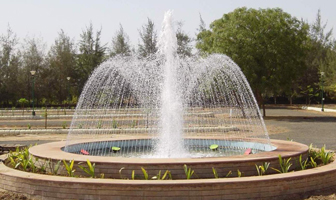
Cascades of water from a fountain
A central column shooting upwards is present in many of the photos and videos. This suggests the presence of a vertical force that ejects matter upwards, which is not consistent with a purely gravitational force. Surrounding this central chimney are plumes of particularized debris. Most of the matter (building contents and materials) has already been turned into small particles by this point.
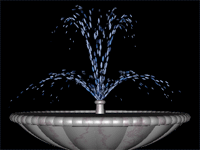
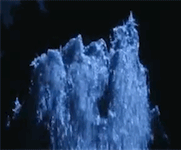

Also, the diameter of the disintegration cloud is not consistent with a pancake gravity-driven collapse. The size of the debris footprint is also not consistent with a vertical gravitational collapse.
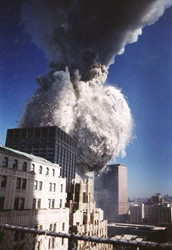
The central column is prominent in this photo.

North Tower
In this GIF below, a central debris plume shoots upwards as a vertical column. On the sides, streamers of debris trace an arc, like in a fountain.

North Tower
Small round clouds of dust are formed as the wave of destruction proceeds downwards. At the end, a dark cloud in a distinctive mushroom shape is seen.

South Tower
Below, at the foot of the tower, large clouds of dust are rising up from the ground.
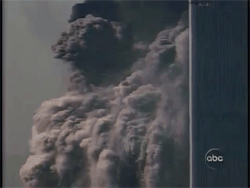
South Tower
A variety of plumes and streamers and a mushroom cloud that twists in a toroidal-like motion are visible.

South Tower
In this GIF below, streamers and plumes of particularized debris form and shoot out from the tower.
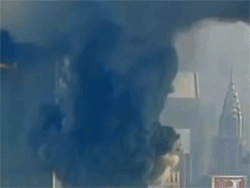
South Tower
WTC detonations–same as underground nuke tests
In these explosions, dirt and debris are thrown up and shoot outwards. Below, at the base of the towers, surge clouds form and spread out, covering the ground.
Comparison chart of underground mini-nuke and WTC nuke
Underground mini-nuke |
World Trade Center |
|
| Size of bomb | Can be less than 1 kton | <1 kton |
| Type of detonation | Underground, in basements, in rock caves underground, buried in the earth | Underground, in basement of building |
| Fireball | Usually not visible | Not visible |
| Crater | Crater or giant cavity underground | Crater, giant pothole formed |
| Mushroom cloud | Huge mushroom cloud high in the air | Small one hugging the building |
| Debris pattern | Debris thrown up and scattered far and wide | Debris thrown up in air, thrown 150 m out |
| Surge clouds | Prominent | Seen |
| Aim | Destroy a structure (building) or a formation (mountain, rock) | Destroy the building |
| Conventional bombs used | Can be used together with the nuke | Yes, initial explosions in WTC are from conventional bombs, used at same time |
| Cancer | Yes, that is why Operation Plowshare was abandoned by the US government | Yes, 1 in 10 WTC workers have cancer (2017) |
Underground nuke tests of Operation Plowshare
The differences between the two types of explosions can be explained by the fact that conventional bombs were used in the September 11 attacks in addition to nuclear bombs. Hence, the GIFS of the WTC (on the right) reflect the combined use of the two types of bombs. In some GIFS of the WTC, multiple explosions can be seen, with small mushroom debris clouds “popping out”. These explosions are detonations of conventional demolition charges (or “squibs”) that were placed in the Towers.
Plumes, streamers, cascades, surge clouds same in underground nukes and WTC nukes
 compared to
compared to 
 compared to
compared to 
 compared to
compared to 
 compared to
compared to 
Bunker buster compared to WTC Towers
 compared to
compared to 
Taken from CNN video
Debris was formed mid-air in WTC detonations–nukes are powerful
Streamers shoot outwards, and the force of the explosion expels heavy steel beams, including massive tridents, outwards, impaling them into buildings 150 meters away.
WARNING: This video is banned on Youtube. You will get a community strike if you upload this video. Use BitChute (non-censoring of political speech) instead.
VIDEO: By Dauvit Magauran ArchiveOrg
“Truth suffers from too much analysis.” Ancient Fremen Saying – Frank Herbert, Dune Messiah (Video originally from a link in Facebook)
Summary of the holes in gravity theory
- Gravity is a downwards force, not a sideways force.
- Gravity lacks the power to smash concrete into fine powder of 0.3 micron in size before it hits the ground.
In purely gravity-driven collapses, such a high volume of particularized debris would not be created. In addition, a force greater than gravity is needed to pulverize all the building materials used in the construction of the floor and the contents of the offices.
Seen is a giant column of debris plume shooting upward at the start of the disintegration cascade. This is reminiscent of powerful explosions, as observed in nuclear explosions and volcanic explosions. It indicates the presence of an upward force, something you would not expect to see in a purely gravity-driven collapse.
A bunker buster in action
The bunker buster penetrates a bunker and then the warhead explodes. Like many underground explosions, much dirt and debris are thrown into the atmosphere. If the bunker buster is nuclear, much local fallout is produced.
VIDEO: Bunker buster in action Youtube
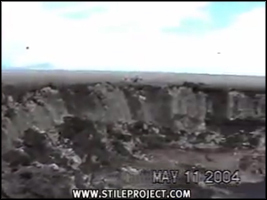
Crater produced by a bunker buster
Conventional weapons and nukes were used to produce a complex pattern of detonations–to fool the viewer
Conventional explosives were detonated alongside with nuclear weapons, creating different types of explosions.
Why were conventional bombs used?
Conventional bombs were needed to make the initial collapse look like a pancake-style gravity-driven collapse, and nuclear bombs were used to destroy the destruction-resistant steel core and to destroy everything, so that no evidence would be left behind, such as bomb fragments, plane fragments, plane missile fragments, and bodies of passengers.
Why were nuclear bombs used with conventional bombs?
Only nuclear weapons can be relied on to completely destroy the evidence. As a result, little forensic examination could be done.
Types of conventional bombs available to the perpetrators
Explosive blends containing ammonium nitrate, including ANFO (ammonium nitrate/fuel oil), an industrial explosive, account for 80% of explosives used in North America. (Read more about the various types of explosives used in demolitions here.)




1) Ammonium nitrate; 2) TNT; 3) Dynamite; 4) Gelignite




5) C4; 6) Semtex; 7) C4; 8) C4
Little flame observed in the WTC detonations
In building implosions due to demolition, little or no flame is observed, unlike collapses and disintegrations due to fire.

Implosion of the Athlone Power Station cooling towers on 22 August 2010. (Wikipedia)
Types of bombs popular among demolition companies
Below is an article on the types of explosives used in demolitions. From: designingbuildings
Types of explosiveThe most commonly used types of explosive for construction demolition are: Slurry explosives: Ammonium nitrate and other nitrates in solution. Materials are sensitised by air during the manufacturing process and have good fume characteristics and are suitable for wet conditions … (cont.) Read more: designingbuildings |
Why beam weapons don’t make sense
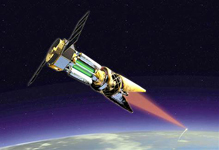
Beam weapons (or directed energy weapons as they are also called) were experimental in 2001, and still today they are largely in the developmental stage and are not deployed for military use except in anti-ballistic missile defense systems in the USA.
The other reason beam weapons don’t make sense is that even though beam weapons produce a strong electromagnetic wave, the wave is only present for a short time – while the beam weapon is deployed. Hence, it would be safe for workers to enter Ground Zero without the risk of being exposed to strong electromagnetic radiation, and developing cancer from that. So beam weapons would not explain the high rates of cancer found in workers and others.
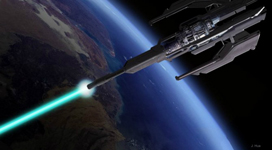 In a nuking, radioactive dust remains in the area until it is removed. Radioactivity is present in debris too. So, while workers remain in the area of radioactive debris and dust, even long after the nuking has taken place, they will be exposed to radiation and can develop cancer as a result.
In a nuking, radioactive dust remains in the area until it is removed. Radioactivity is present in debris too. So, while workers remain in the area of radioactive debris and dust, even long after the nuking has taken place, they will be exposed to radiation and can develop cancer as a result.
Therefore, many more people are likely to acquire cancer in a nuking site than in a site that has been struck by a beam weapon.
National firefighters study in America
The September 11 attacks were a one-time event. The studies that show an increase in cancer relate to lifetime exposure while working as a firefighter. It is unprecedented that a single event like the 9/11 attacks can cause such an increase in cancer.
Masks were also worn and the air quality was monitored for toxins. No unacceptably high levels of air toxins were found. This is the reason many workers were not given medical coverage for their conditions. Their illnesses were not consistent with the levels of exposure to toxins (PAHC, asbestos, silicates, PBCs, etc) measured in the air. No alarms were sounded about unacceptably high levels of air toxins, and work was not interrupted.
Masks would have reduced inhalation of most toxins, including asbestos, to acceptable levels.
Furthermore, some people who were not exposed to the air at the WTC because they worked at the Fresh Kills landfill site, unloading and sorting out debris, also got high rates of cancer.
Additionally, the high cancer incidence, if due to toxins in the air, would be more evenly distributed over New York State, as air, and the toxins within it, quickly disperses. The WTC clean-up was, in essence, an ordinary demolition job. No demolition of high rises is known to cause this catastrophic picture of high cancer rates.
In addition, the rate of increase in cancer (it tripled between 2012 and 2015) is rarely seen in cancer situations caused by air toxins. The rapid increase in cancer rates match that seen in radiation exposure in nuclear accidents. Radiation is one of the most carcinogenic agents known to man.
Radiation-induced mesothelioma can have a short latency period of 0-4 years after exposure. This sort of latency period is never seen in asbestosis-induced mesothelioma, so asbestos can be ruled out as a cause in the several people who acquired mesothelioma in less than 10 years after their work at the site. One worker, 41 years of age, died of mesothelioma 3 years after 9/11. The latency period for asbestos-caused mesothelioma is 15-30 years.
The increase in leukemias among those exposed at the WTC site is higher than that seen among Hiroshima survivors.
Debunking other theories–a summary
The table below shows that the nuclear theory is the only one that accounts for all the evidence found
Nuclear weapon |
Thermite |
Directed energy weapon (DEW) |
|
| Can cause cancer rate of 1 in 10 workers | Yes, nukes produce ionizing radiation | No. No studies link thermite to cancer.
Fresh Kills landfill workers who did not breathe the air at WTC also got high rates of cancer. |
No. Only at the time of firing is EM radiation produced. Workers who came to the site after the strike got cancer. |
| Can cause early-onset mesothelioma | Yes, ionizing radiation is the only known cause of early-onset of mesothelioma. | No. Asbestos never causes early-onset cancer. Minimum latency period is 15 years. WTC workers got mesothelioma as early after 2 and 5 years. | No. Only short duration of EM radiation |
| Can throw 10-ton steel beams 150 meters out | Yes, blast wave produced in a nuclear explosion can throw heavy debris far distances. | No, thermite is a very weak explosive. | No. |
| Can produce a giant crater 40 feet deep | Yes, underground nuclear detonations produce craters and cavities in rock. | No, not powerful enough. | Perhaps; DEW are still experimental. |
| Can destroy 500,000 tons of concrete into fine particles as small as 0.3 microns | Yes, blast wave are typically powerful in nuclear explosions, particularization of matter occurs. | No, thermite experiment using 6 pounds of thermite could not displace or destroy 1 brick | Perhaps; DEW are still experimental. |
| Can produce molten metal that persists for months | Yes, the nuclear explosion produces thermal wave that can melt steel; millions of degrees in the center of the fireball. | No. | Perhaps; DEW are still experimental. |
| Can bend 10-ton beams into pretzel shapes | Yes, the tremendous heat produced by nukes can make steel beams pliable; millions of degrees of Celsius in the center of a fireball. | No, thermite does not generate enough heat. | Perhaps; DEW are still experimental. |
| Can toast cars >200 meters away | Yes. Many toasted vehicles in the Hiroshima bombing that were far from the hypocenter (e.g. 300 meters). | No, thermite cannot generate high enough temperatures. | Perhaps; DEW are still experimental. |
| Can make people ‘disappear’ | Yes, many people disappeared in the Hiroshima bombing | No, can burn people but doesn’t make them disappear. | Perhaps; DEW are still experimental. |
| Can fuse objects together | Yes, many objects were fused in Hiroshima and Nagasaki. | No, does not generate high enough temperatures | Perhaps; DEW are still experimental. |
| Can cause fission products at the site (strontium, barium, cesium, tritium) to appear at site | Yes, the nuclear reaction involves the creation of fission products. | No. | No. |
| Can cause an overpressure of 20 psi at 150 meters from the hypocenter | Yes, 1 kton nuclear bomb detonated underground can produces a blastwave that can cause this level of destruction. | No, thermite is a weak explosive. | Unlikely, DEW is still experimental. |
_____________________________________
 _____________________________________
_____________________________________

_____________________________________
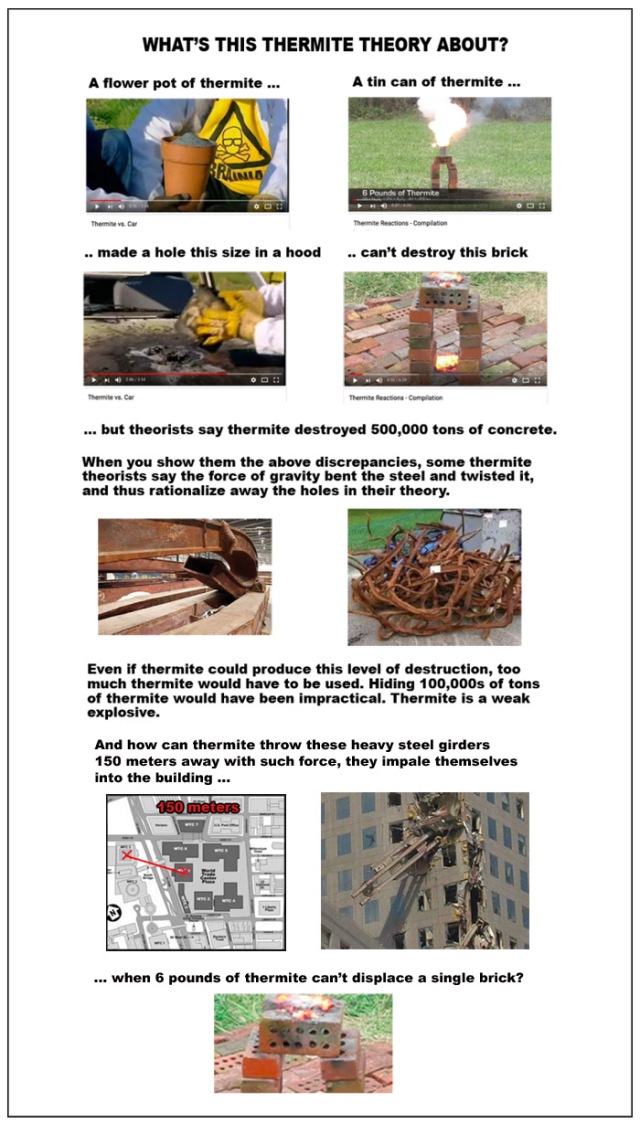
______________________________________

#tacticalnuke
#craters
#pothole
#comparison
#cancers
#thermite
#flowerpot
#comparisongifs
#beamweapons
#conventionalbombs

